25 AUGUST–08 SEPTEMBER 2023
By Joshua Olszewski and Dominic Rollinson
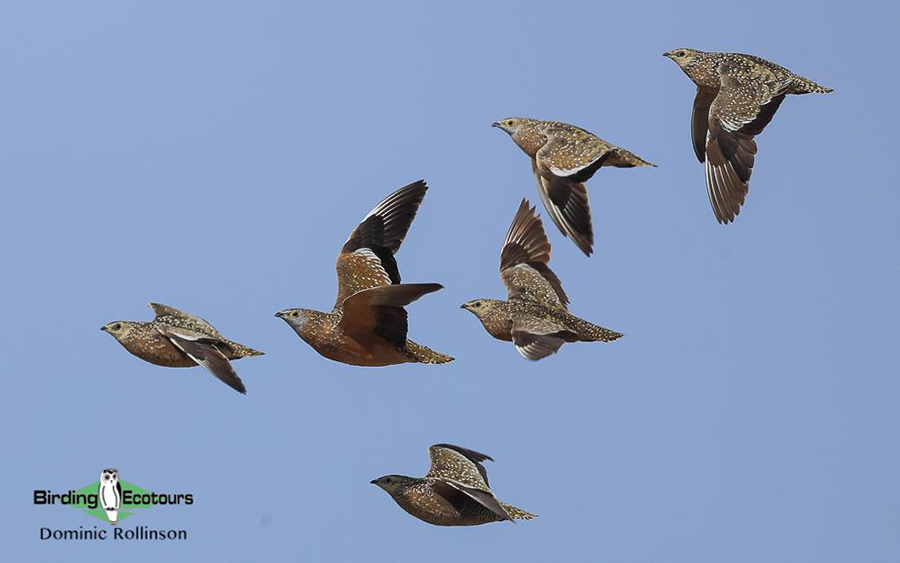
Burchell’s Sandgrouse is a Kalahari special that we saw well on this western South Africa birding tour.
Overview
Set towards the tail end of the Cape’s rainy winter season and before the Kalahari temperatures warm up too drastically, this South African birding tour was designed to make the most of the prolificacy of the southwestern South African spring. We targeted as many of the 300-odd bird species that occur across this region, with the emphasis on finding endemics, as well as to witness the spectacle of millions of brightly-colored flowers that bloom over the western coastal regions of South Africa at this time of year. The tour also included a few days in the Kalahari with its scenic red dunes, where the dry river beds act as a magnet for large animals and birds of prey.
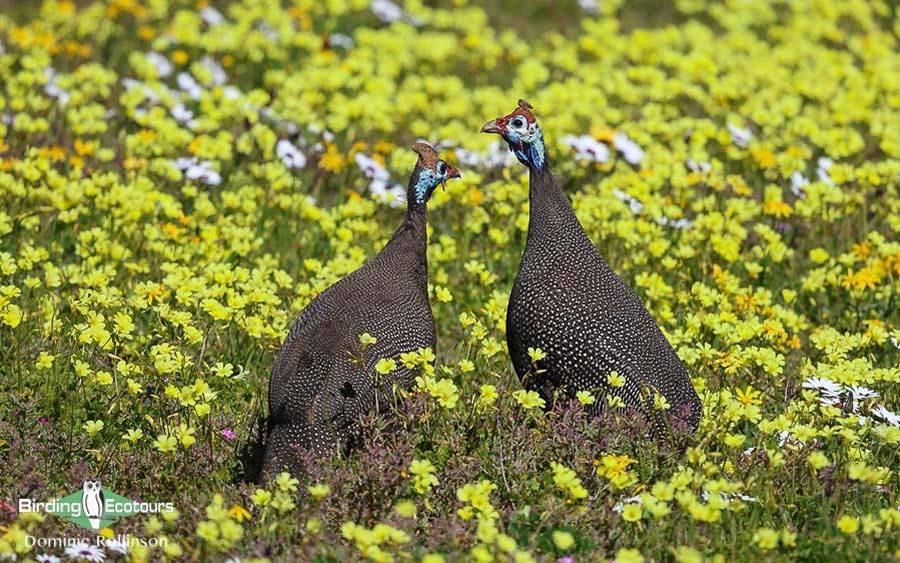
The flowers of West Coast National Park made widespread species, such as these Helmeted Guineafowl, more photogenic.
Some of the major birding highlights included Black Harrier, Martial Eagle, White-backed and Lappet-faced Vultures, Pygmy Falcon, Maccoa Duck, Chestnut-banded Plover, Southern Black Korhaan, Ludwig’s Bustard, Rosy-faced Lovebird, Swallow-tailed Bee-eater, Cinnamon-breasted Warbler, Karoo Eremomela, Cape Rockjumper, Victorin’s Warbler, Orange-breasted Sunbird, Cape Sugarbird, and Protea Canary.This western South Africa birding tour is particularly notable for its diversity of larks, with 15 species seen, including Cape Clapper, Cape Long-billed, Karoo Long-billed, Stark’s, Karoo, Barlow’s, Red, and Fawn-colored Larks, as well as the enigmatic Sclater’s Lark. We also got to enjoy a variety of large mammal species in the well-known Kgalagadi Transfrontier Park, which included Cheetah, Leopard, Gemsbok (Southern Oryx), Springbok, Cape Fox, Meerkat (Suricate) and South African Ground Squirrel, whilst outside the park we managed to find elusive species such as Bat-eared Fox and Aardwolf.

Cheetah posed well for us in the Kgalagadi Transfrontier Park.
Detailed Report
Day 1, 25th August 2023. Arrival in Cape Town
We managed to get some birding done on the afternoon of our clients’ arrival in Cape Town, starting off with a Peregrine Falcon perched on the airport building. A stop along the Liesbeek River delivered a few good waterbirds including Malachite Kingfisher, African Black Duck, Yellow-billed Duck and Cape Weaver,as well as a Black-winged Kite and a surprise flyby from a Black Sparrowhawk.
That afternoon, we paid a mandatory visit to the well-known Strandfontein Sewage Works, which bolstered our bird list with a variety of water-associated species, among which were ducks like Maccoa Duck, Yellow-billed Duck, Red-billed Teal, Cape Teal, Blue-billed Teal, Southern Pochard, Cape Shoveler and Fulvous Whistling Duck. Other waterbirds included the likes of Little, Black-necked and Great Crested Grebes, Lesser Swamp and Little Rush Warblers, Greater Flamingo, African Swamphen, Red-knobbed Coot, Black-winged Stilt, Pied Avocet, Purple Heron, Levaillant’s Cisticola, White-throated Swallow and Brown-throated Martin,as well as singleton flybys from Jackal Buzzard, African Fish Eagle and African Marsh Harrier. We managed to pick out a few Grey-headed Gulls in and amongst the hundreds of Hartlaub’s Gulls and Kelp Gulls that are normally present, and African Sacred Ibis were also numerous, as always.
Day 2, 26th August 2023. Cape Rockjumpers and Betty’s Bay birding
Our first full day of tour commenced with an early morning drive from Cape Town down the beautiful Clarence Drive along the eastern shores of False Bay, towards the coastal holiday town of Betty’s Bay. We first stopped at a small wetland in the mountains near Pringle Bay, where we searched for the elusive Striped Flufftail, without luck. However, we did manage to find Neddicky, Levaillant’s Cisticola, Karoo Prinia, Grey-backed Cisticola, Cape Bulbul, Cape Robin-Chat and Ring-necked Dove.
We then moved across to the tiny town of Rooi Els, just west of Betty’s Bay, set alongside dramatic mountain peaks right on the seafront. It was here where we searched for the charismatic Cape Rockjumper, of which we enjoyed two males foraging on the boulder-strewn slopes. In the general area, we also saw Yellow Bishop, Cape Rock Thrush, Cape Bulbul, Cape Grassbird, White-necked Raven, Grey-backed Cisticola, Southern Double-collared Sunbird, Cape Bunting, Cape White-eye, Cape Sugarbird and lots of gorgeous Orange-breasted Sunbirds. Scanning out to sea here revealed Cape Cormorant, Greater Crested Tern, Sooty Shearwater, White-chinned Petrel and Shy Albatross, as well as Afro-Australian Fur Seals on the nearby rocks.
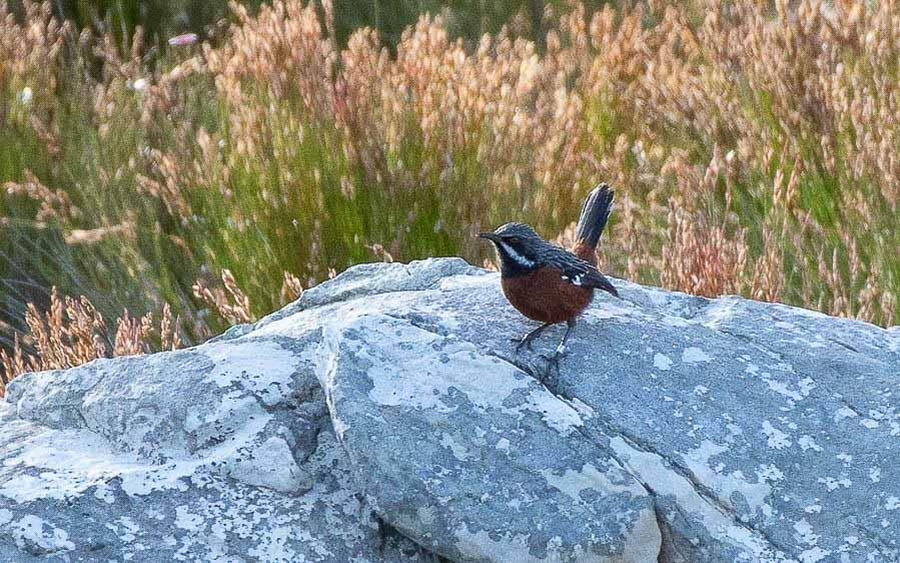
This ringed male Cape Rockjumper was seen at Rooi Els (photo, tour participant, Jake Zadik).
Our next stop was the renowned African Penguin colony at Stony Point in Betty’s Bay, where we enjoyed countless looks at these Endangered, yet quirky, near-endemics, as well as the cormorant breeding colony on the promontory, which comprises of White-breasted, Cape, Crowned and Bank Cormorants. Other good birds seen here were African Oystercatcher, Shy Albatross, Brown Skua, Little Egret,and Greater Crested Tern.
We then made our way to the picturesque Harold Porter Botanical Gardens for a picnic lunch and a lovely walk around, where we got in touch with species like Cape Batis, Brimstone Canary, Bar-throated Apalis, Olive Thrush, Yellow Bishop and African Dusky Flycatcher,in addition to many previously mentioned species from Rooi Els. A troop of feisty Chacma Baboons also kept us entertained and guarding our lunch packs!
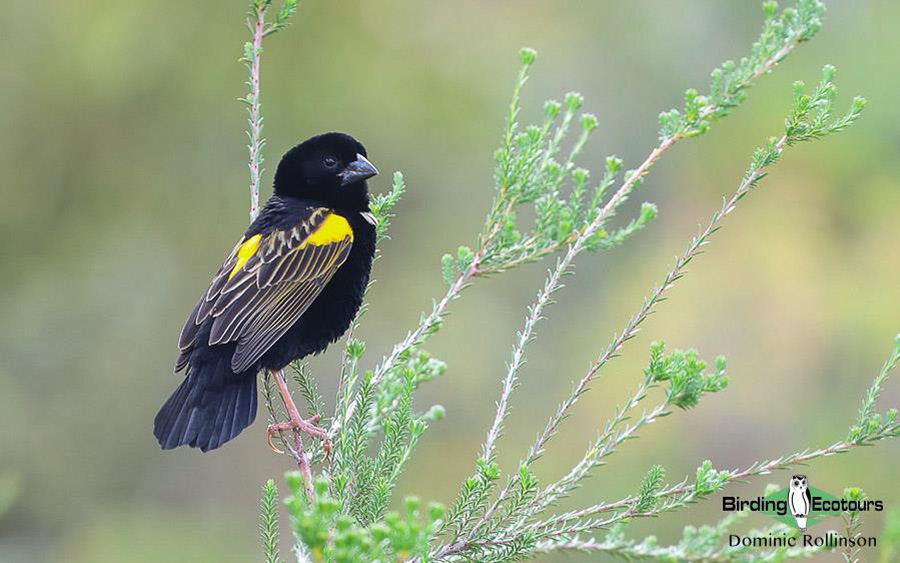
Yellow Bishop in the fynbos of Harold Porter Botanical Garden.
The drive back home was broken by a short hike up the mountains alongside the scenic Sir Lowry’s Pass, where we got views of the cryptic Victorin’s Warbler.We attempted to flush the rare Fynbos Buttonquail, sadly to no avail, but this did result in us getting the endemic Cape Siskin, as well as a few previously seen species such Malachite Sunbird, Cape Grassbird, White-necked Raven, Cape Sugarbird and Orange-breasted Sunbird.After dinner, we paid a visit to a local patch of forest in search of African Wood Owl, but instead were treated to the ghostly hooting song of a Buff-spotted Flufftail calling from a thicket within the forest.
Day 3, 27th August 2023. Kirstenbosch Botanical Garden birding and transfer to Langebaan
After a great breakfast at our lodge, we headed out for a walk through the magnificent Kirstenbosch National Botanical Garden. With splendid weather and an empty garden due to it being early on a Sunday morning, we got to enjoy the many avian delights of the garden in relative peace. Some of the highlights included the resident pair of Spotted Eagle-Owls roosting at their nest site, displaying Brown-backed Honeybirds performing their aerial pursuit display flights, multiple Black Sparrowhawk flybys, a high-flying pair of Booted Eagles and an African Harrier-Hawk also performing its vocal display flight. We were treated to a plethora of species during our time in the gardens, such as Forest Canary, Cape Canary, Brimstone Canary, Cape Batis, Sombre Greenbul, Southern Boubou, Speckled Mousebird, Swee Waxbill, African Olive Pigeon, Amethyst and Southern Double-collared Sunbirds, Olive Woodpecker, Fork-tailed Drongo, African Dusky Flycatcher, Common Buzzard, Bar-throated Apalis, White-necked Raven and the ever-present Hadada Ibis and Egyptian Geese.
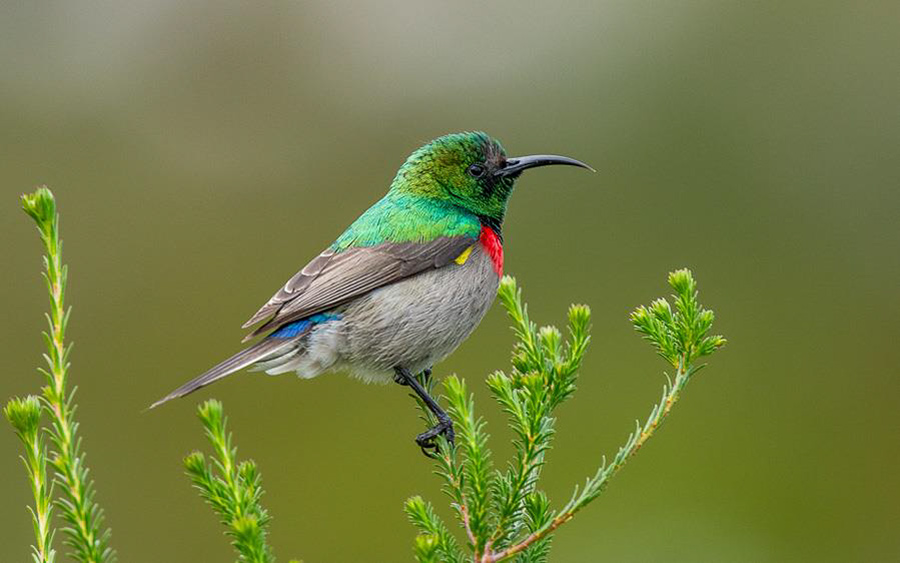
Southern Double-collared Sunbirds were common in Kirstenbosch Botanical Garden (photo, tour participant, Jake Zadik).
Leaving the gardens around midday, we made our way north of Cape Town along the west coast, trading dramatic mountains for strandveld-covered sand dunes. A small pan on the northern fringes of the city played host to a couple of peculiar White-backed Ducks,as well as African Darter, Reed Cormorant, Southern Red Bishop, Southern Masked Weaver, Cape Shoveler, Grey Heron, White-throated Swallow, Brown-throated Martin and, in the surrounding vegetation, Red-faced Mousebirds and a female Pin-tailed Whydah.A surprising reptilian find here came in the form of a small, but beautifully marked Spotted Skaapsteeker dashing between our feet next to the sidewalk – our first snake of the trip.
We made a brief roadside lunch stop in some strandveld near Silwerstroomstrand, where we got stunning views of the tricky Cape Clapper Lark and started coming to grips with species that are characteristic of this new habitat, such as Chestnut-vented Warbler and White-backed Mousebird.Not long after seeing our first snake of the trip, we found a massive black Mole Snake buried under a low shrub close to the road at this spot. This was also around the time when we started noticing the glowing swathes of orange, yellow and white flowers that carpet the landscape at this time of year – a trademark feature of springtime in the western parts of South Africa. We got a chance to indulge ourselves in the glorious blooms at Tienie Versveld Wildflower Reserve further along the west coast road. Despite the bustling tourists, we also managed to eke out a couple of new birds for the trip, namely the diminutive Cloud Cisticola (a mere speck in the sky as they performed their high ‘cloud-scraping’ display flights), the striking Cape Longclaw,and looks at more common species like Spur-winged Goose, Rock Kestrel, Capped Wheatear, Large-billed Lark, Red-capped Lark, African Pipit and Greater Striped Swallow.A soaring Lanner Falcon was also a welcome find here.
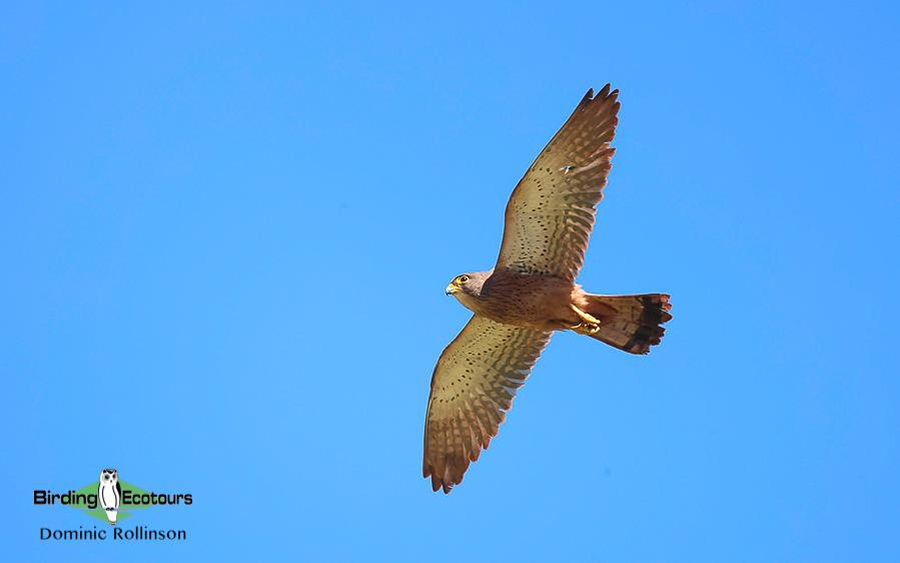
Rock Kestrel was widespread and abundant throughout western South Africa.
Continuing along our route towards the town of Langebaan, we picked up more new species along the road, such as Yellow-billed Kite, Blue Crane, Little Swift and our first looks at the attractive Southern Black Korhaan.Upon checking into our guesthouse, we took a break from birding by car and unwound for a moment, enjoying some balcony-birding over the next-door golf course. Breeding male Southern Red Bishops and Cape Weavers displaying to passing females and gathering nesting materials were quite an enjoyable sight, whilst African Sacred Ibis, Helmeted Guineafowl, White-backed Mousebird and Crowned Lapwing all made up the suite of garden birds on offer from our accommodation.
A late afternoon drive towards Jacob’s Bay, just north of Langebaan, proved to be particularly fruitful, delivering a stunning Black Harrier flying alongside our vehicle for a kilometer or two. One or two roadside stops along the way delivered Cape Long-billed Lark, Sickle-winged Chat, Ant-eating Chat, Wattled and Pied Starlings, Yellow Canary, Blue Crane, Pearl-breasted Swallow, Spotted Thick-knee, Southern Masked Weaver, Grey Tit, and Karoo Lark, amongst many species seen earlier. The rocky shoreline of the Mauritzbaai section of town gave us great views of the sought-after Antarctic Tern, accompanied by White-fronted Plovers, Greater Crested Terns and Crowned Cormorants. Driving back to Langebaan gave us one more Southern Black Korhaan, along with Black-winged Kite and Rock Kestrel, to end off another brilliant day of birding.
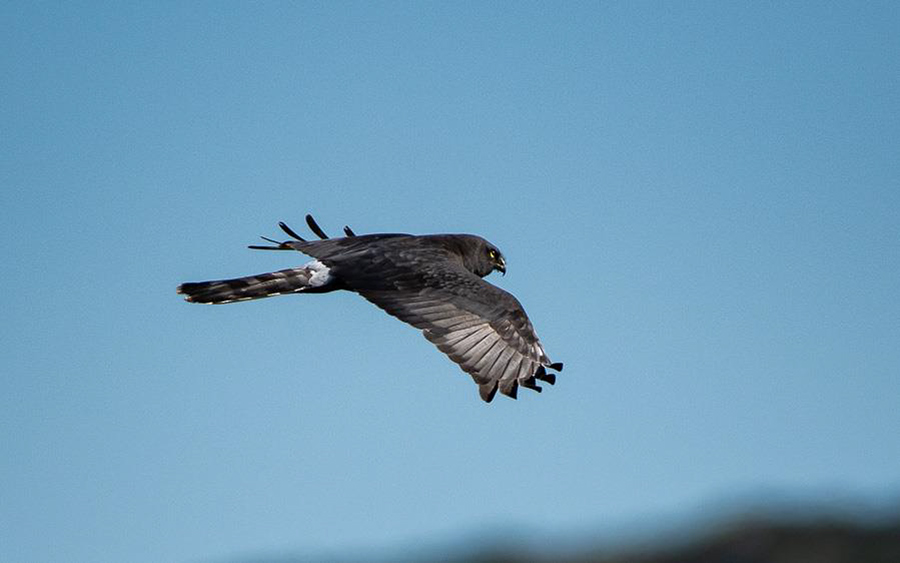
Black Harrier was seen on several occasions while up the west coast (photo, tour participant, Jake Zadik).
Day 4, 28th August 2023. West Coast National Park birding
Most of today was spent in the pristine West Coast National Park, situated at the southern end of the town of Langebaan and encompassing the picturesque Langebaan lagoon. Within the vicinity of the park’s northern gate, we already had a handful of good sightings, namely our first looks at the exquisite Bokmakierie and a covey of Grey-winged Francolins in the road just a few hundred meters past the gate. We traveled south down the road that runs along the eastern side of the lagoon, enjoying the rose-gold sunrise and the regular suite of strandveld birds as we went, including White-backed Mousebird, Bar-throated Apalis, Southern Double-collared Sunbird, Cape Bulbul, Grey-backed Cisticola, Cape Spurfowl and Southern Fiscal.
Our first stop was at the Geelbek hide that overlooks the lagoon from its southern end. At low tide, the water recedes dramatically, exposing mudflats upon which hundreds of migratory waders search for marine invertebrates, supplemented by a host of resident species. Highlights from the hide included Eurasian Curlew, Eurasian Whimbrel, Bar-tailed Godwit, Curlew Sandpiper, Little Stint, Ruddy Turnstone, African Oystercatcher, Black-winged Stilt, Pied Avocet, African Spoonbill, Caspian Tern, Sandwich Tern, Kittlitz’s Plover, White-fronted Plover, Grey Plover, White-throated Swallow and hundreds of Greater and Lesser Flamingos. Most excitingly, we found a single Terek Sandpiper and a group of Red Knots. A massive herd of Common Eland across the road from the hide was a definite mammalian highlight.
After having breakfast in the Geelbek hide, we moved across to the Abrahamskraal hide, situated on the edge of a small, reed-lined freshwater pool. On the way to the hide, we picked out Long-billed Crombec and had stunning roadside views of a Cape Longclaw. Within the vicinity of the hide itself, we found our first Karoo Scrub Robin,had a pair of South African Shelducks flying past, and got mouth-watering views of a singing Southern Black Korhaan walking in the road. Crowned Lapwing, Cape Shoveler, Yellow Canary, Jackal Buzzard, Bokmakierie and Red-knobbed Coot were also seen from the hide. Continuing our journey northward along the western arm of the lagoon road, we managed to find an adorable Cape Penduline Tit and added Malachite Sunbird to our day list before reaching the start of the Postberg section of the park and the end of the peninsula.
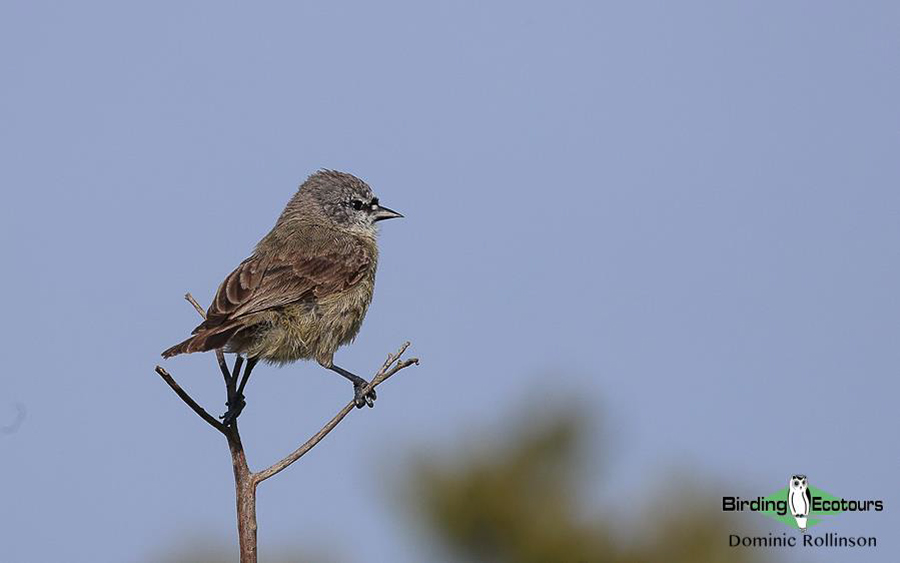
The cute Cape Penduline Tit in West Coast National Park.
This section is closed for most of the year, but for a few weeks in August and September, it is opened to the public. This area is world-renowned for the spectacle of millions of colorful flowers, mostly daisies, which bloom during this short period of early spring. Thousands of people visit Postberg each year to observe and indulge themselves in the glorious array of flowers that carpet the hills here in white, yellow, orange and purple. We took the time to enjoy this beautiful phenomenon, whilst getting some birding done at the same time. A pair of Black Harriers flying low overhead with prey were a welcome distraction from the flowers, as were the regal (Cape) Mountain Zebra and Blesbok (here of the Cape subspecies often known as Bontebok) that stood lazily amongst the flowers. Crowned Lapwing, Spotted Thick-knee, Cape Spurfowl, Large-billed Lark, Red-capped Lark and Western Cattle Egret were all seen amidst the blooms, and flocks of Kelp and Hartlaub’s Gulls hawked low over the shrubbery, catching flying insects. All the while, Jackal Buzzard and yet another Black Harrier soared overhead. The coastline at Plankiesbaai further rewarded us with a couple of hunting Antarctic Terns, Afro-Australian Fur Seals and a pod of Heaviside’s Dolphins. These small, attractive dolphins are endemic to the Benguela Current and are found only along the coasts of Namibia and western South Africa, so it was a real treat to lay eyes on these creatures.
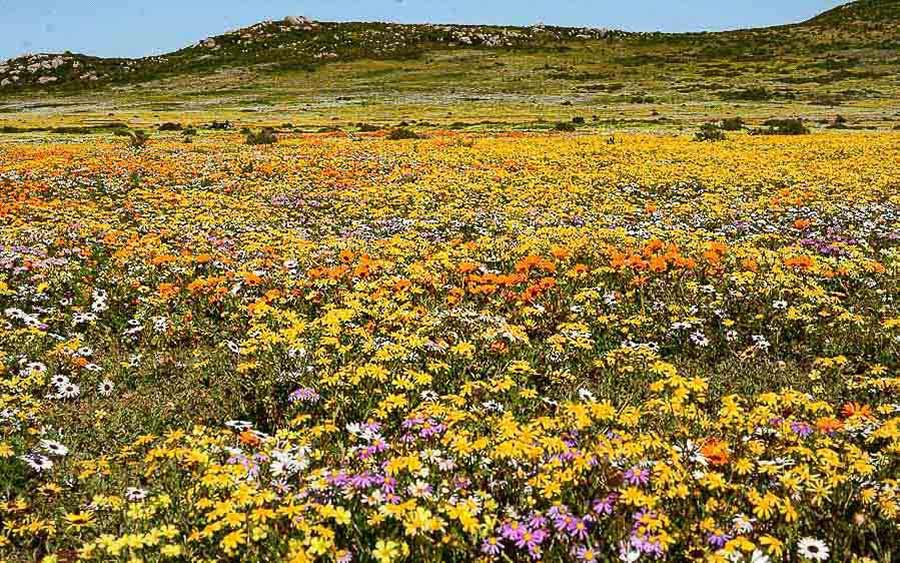
We were treated to amazing floral carpets in West Coast National Park (photo, tour participant, Juliana Smith).
Other interesting birds seen in the Postberg section included Pearl-breasted Swallow, Chestnut-vented Warbler, Crowned Cormorant, Cape Bunting and our first looks at White-throated Canary for the trip. Upon leaving Postberg, we bumped into our final Black Harrier of the day before heading back to Geelbek for lunch at the manor house restaurant. As we waited for our food, we took a quick stroll around the eucalyptus stands behind the house, which revealed Pearl-breasted Swallows, a showy male Cardinal Woodpecker and Rock Martins flying around the treetops. A trio of vibrant African Hoopoe in hot pursuit of one another saw us off as we left Geelbek and proceeded back to Langebaan. After leaving the park, we paid a visit to the Langebaan Quarry, situated on the outskirts of town, and home to a pair of magnificent Verreaux’s Eagles,which have bred here for many years. We were fortunate enough to see one of these majestic raptors perched on top of the quarry, as well as seeing it gliding effortlessly, on immense wings, across the quarry. Other birds seen in the quarry included Pied Starling, Brown-throated Martin, Rock Kestrel, African Black Swift, Southern Fiscal, Black-headed Heron and Lesser Swamp Warbler.
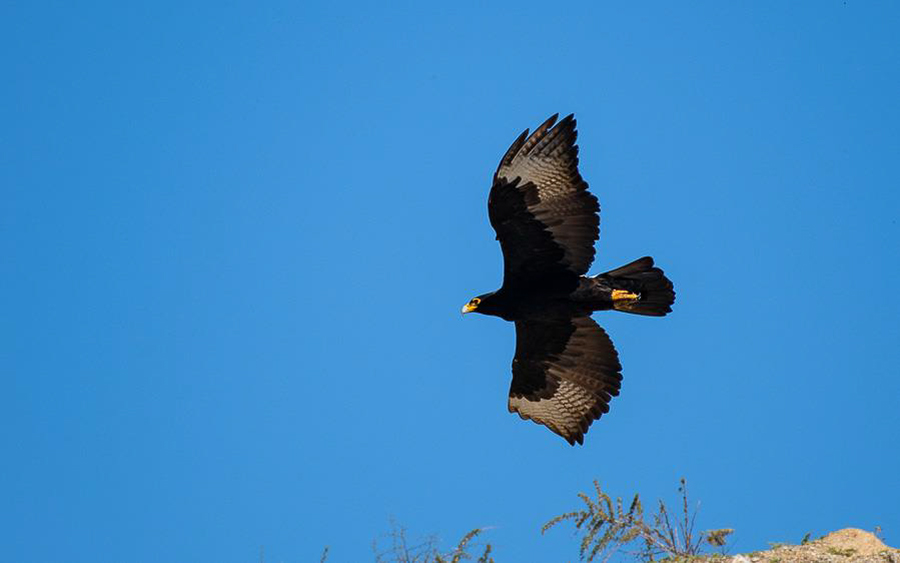
The striking Verreaux’s Eagle in Langebaan (photo, tour participant, Jake Zadik).
We returned to the guesthouse after the quarry visit and relaxed for the late afternoon before heading out for dinner, after which we found a Cape Grysbok on the roadside coming back into town. We then went for a short night walk around the coastal brush near Langebaan, where we found the endemic Namaqua (Western) Dwarf Chameleon. Our final sighting of the day was a couple of vocal Fiery-necked Nightjars just outside the park’s gate.
Day 5: 29th August 2023. Velddrif birding and transfer to the Namaqualand
We had a later start this morning to enjoy a sit-down breakfast at our lodge before getting back on the road, heading north in the direction of Namaqualand, and enjoying calling Southern Black Korhaans and Blue Cranes along the way. We had a morning stop at the coastal town of Velddrif, about an hour north of Langebaan, situated near the mouth of the Berg River. The expansive wetland formed here by the river, as well as the multiple salt works around the mouth create prime habitat for a variety of coastal birds. Kliphoek salt pans, in particular, was quite rewarding, giving us plenty of Chestnut-banded Plovers (some with chicks), as well as Three-banded Plover, Common Sandpiper, Ruff, Black-crowned Night Heron, African Spoonbill, Cape Shoveler, Cape Teal, Red-billed Teal, South African Shelduck, Glossy Ibis, Common Tern, Large-billed Lark, Red-capped Lark, Karoo Scrub Robin, Pearl-breasted Swallow, Banded Martin, White-throated Swallow, Black-winged Stilt and Pied Avocet. We further enjoyed large flocks of Black-necked Grebes, close views of African Marsh Harrier, the resident Red-necked Phalarope and, surprisingly, the vagrant Pink-backed Pelican that has been moving around the Cape since 2021. We also had a brief visual here of the adorable Bush Karoo Rat.
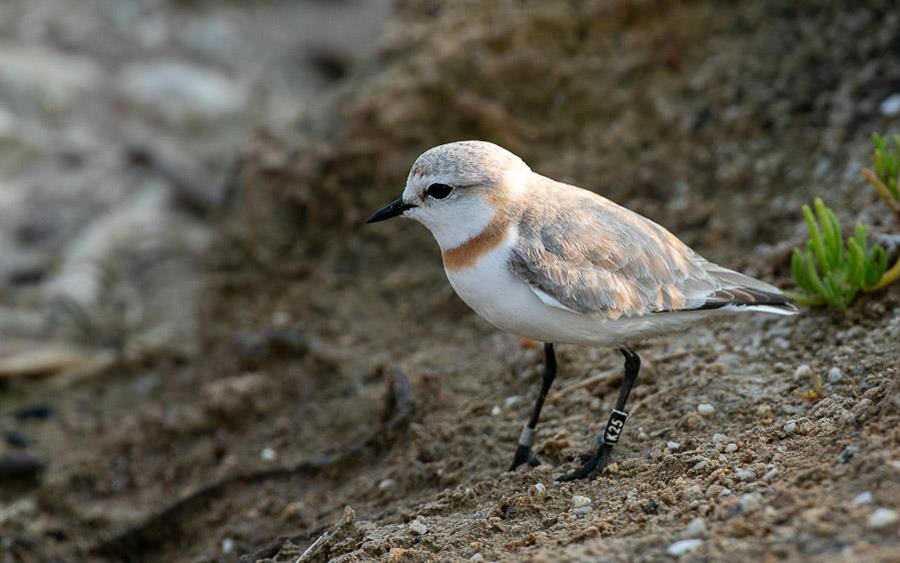
As always, Chestnut-banded Plovers were numerous in Velddrif (photo, tour participant, Jake Zadik).
We then made a couple of brief stops along the northern shoreline of the wide section of the Berg River near town, which allowed us to get amazing views of some of the more common waterbirds, namely Great White Pelican, Pied Kingfisher, Little Egret, Lesser and Greater Flamingos and Grey-headed Gull,as well as Red-faced Mousebirds and a pair of Booted Eagles.We heard African Rail at these spots too, but unfortunately could not get any visuals. We then left Velddrif and started the long drive to Springbok, getting a few interesting birds as we went including Pale Chanting Goshawk, Blue Crane, Jackal Buzzard, Greater Kestrel, Cape Crow, African Black Swift, Yellow-billed Kite and Rock Kestrel.
Upon our arrival, we were greeted at our hotel by their resident pair of Mountain Wheatears that breed in the reception area inside the building, accompanied by their two very confiding fledglings that were hopping around the lounge furniture. After dinner, we went for a night drive near Goegap Nature Reserve on the outskirts of town, where we connected with a very distant Freckled Nightjar,as well as a Spotted Eagle-Owl and the Namaqualand-endemic Paradise Toad.
Day 6, 30th August 2023. Port Nolloth birding and Namaqualand wildflowers
We departed our lodging early this morning in order to get to the coastal town of Port Nolloth, about an hour and a half west of Springbok. Our priority here was to find the highly localized Barlow’s Lark,only found in a narrow strip of coastal dunes in South Africa and southern Namibia. We managed to find a couple of these larks performing their aerial display flights, with a few briefly perching as well. The low, open scrub on the dunes here also played host to Karoo Scrub Robin, Grey-backed Cisticola, Cape Long-billed Lark and the charismatic Tractrac Chat,whilst small groups of Lark-like Buntings,a pair of Namaqua Sandgrouse and a single Black Harrier, all gave us brief flybys.
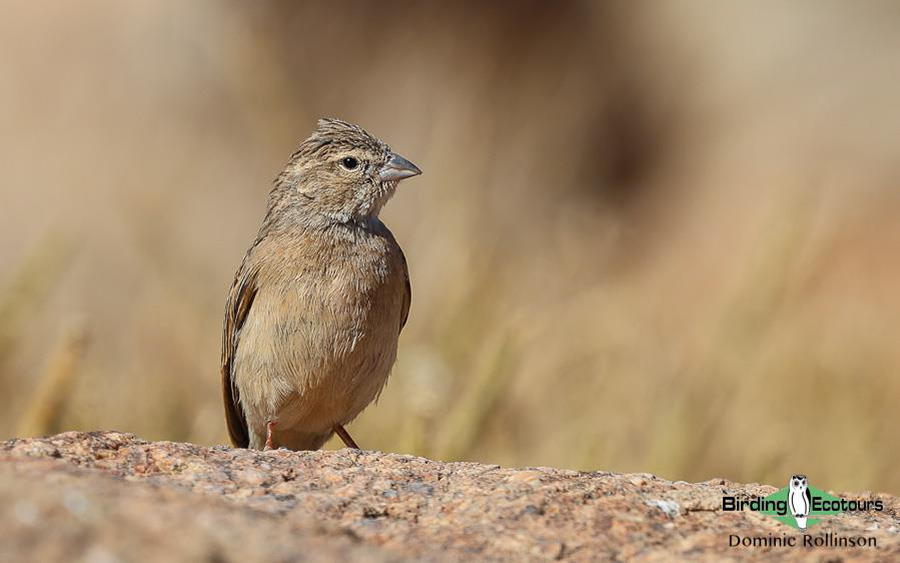
Nomadic Lark-like Buntings were rather widespread on this birding tour.
On the way out of town, we made a quick stop on the beachfront to get in some coastal species for the day, which included Kelp Gull, Hartlaub’s Gull, White-fronted Plover, Crowned Cormorant, Cape Cormorant,and White-breasted Cormorant.The road between Steinkopf and Port Nolloth also delivered some good birds, best of all were considerable numbers of Ludwig’s Bustard,as well as Karoo Lark and the ever-present Cape Crows and Greater Kestrels that nest on the telephone poles across Namaqualand. These kestrels are abundant in this part of the country because they take over the abandoned crow nests, of which there are many to choose from.
We made a quick stop along this road on our way back to enjoy the expansive fields of orange Arctotis daisies and yellow sorrel flowers, which turned out to be a great birding stop as well. We had multiple groups of Namaqua Sandgrouse,two Ludwig’s Bustards,a pair of Grey-backed Sparrow-Larks and a group ofnomadic Black-eared Sparrow-Larks,all giving us flyby views. We also enjoyed a very vocal Rufous-eared Warbler here.
We then returned to our hotel for lunch and a much-needed rest break, enjoying the Rock Martins drinking from the pool in low, swooping flights, before heading out again in the late afternoon. This time, we headed west of Springbok towards the village of Nababeep and onwards to the stunning Spektakel Pass, making roadside stops as we went. The floral displays here were mind-blowing, with this season being the best floral season in decades, and we enjoyed walking around enjoying and photographing the flowers and taking in the incredible views. The birding in the general area was good too, and we soon found Orange River White-eye, African Red-eyed Bulbul, Cape Starling, Karoo Eremomela, Karoo Long-billed Lark, Karoo Chat, Ground Woodpecker and Layard’s Warbler,along with species we had previously seen like Rufous-eared Warbler and Ant-eating Chat.
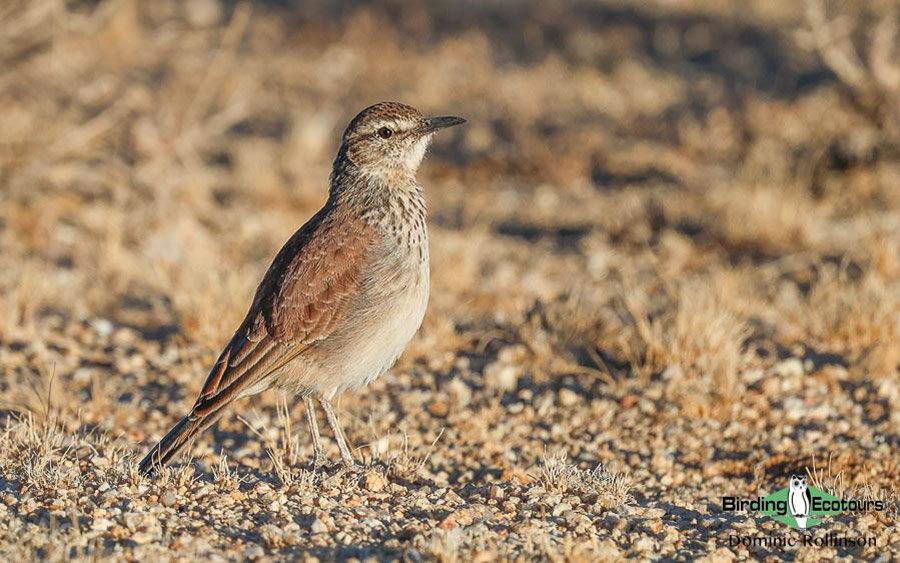
Karoo Long-billed Lark was seen well near Nababeep.
Day 7, 31st August 2023. Goegap Nature Reserve birding and transfer to Pofadder
This morning was spent ambling around the exquisite, flower-strewn scenery of Goegap Nature Reserve, five minutes outside of Springbok town. The valleys and roadsides that cut between the massive boulder-composed outcrops were inundated with the gaudy colors of millions of daisies, and we managed to enjoy some terrific birding during our three-hour stint in the reserve. Our main target here was the sought-after Cinnamon-breasted Warbler, a small, dark, prinia-like warbler with specific habitat preferences, occurring atop chains of large, boulder-strewn koppies. We located one bird singing high up on top of one of these koppies near the picnic area, and got semi-distant but satisfying views of it singing its heart out high up on the koppies – typical behavior for this species.
While birding in Goegap, we also connected with many other Karoo and Namaqualand specials, like Karoo Chat, Ludwig’s Bustard, Black-eared Sparrow-Lark, Layard’s Warbler (many, including birds carrying food to their nest), Karoo Eremomela (particularly common in this reserve), Grey Tit, Acacia Pied Barbet (a pair breeding near the gate), Pale-winged Starling, Nicholson’s Pipit, Dusky Sunbird, Lark-like Bunting and White-throated Canary. Other wildlife highlights included reptiles like Red-sided Skink, Southern Rock Agama, Bibron’s Gecko and Namaqua Sand Lizard, and a family of Dassie Rats (including five babies) near the visitor’s center.
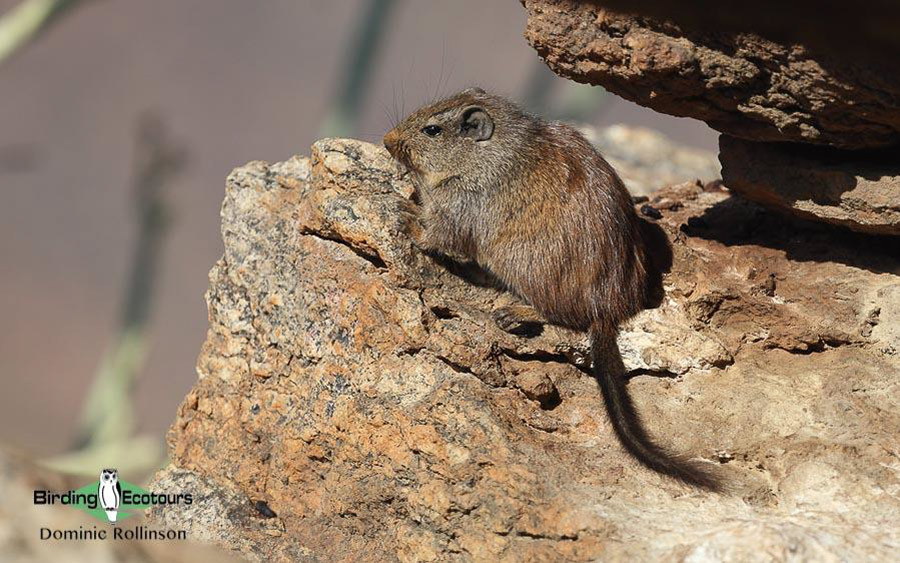
This Dassie Rat struck a good pose at Goegap Nature Reserve.
After a delicious lunch in Springbok, we departed Namaqualand and made our way east towards the small town of Pofadder, 60 kilometers south of the Orange River. Trading the rocky koppies for flat, sandy plains, we made a short roadside stop in this new habitat and quickly picked up the nomadic Stark’s Lark. The birds were displaying above the plains, which were coated in white Heliophila flowers, making for a very memorable sighting, and scent! We then continued our way to Pofadder, observing the change in habitat from succulent Karoo, marked by the rocky, species-rich hills of Namaqualand, to the desolate plains of the Nama Karoo. It was also from here that we saw the first of many Sociable Weaver nests, sitting like giant haystacks on the telephone poles, as well as many Quiver Trees in the area.
Upon arriving in Pofadder and after checking into our lodging, we went out for a late afternoon drive. The first few kilometers of this road delivered quite a few good species, including Double-banded Courser, Karoo Korhaan, Northern Black Korhaan, Chat Flycatcher, Karoo Chat, Stark’s Lark and, best of all, a distant flying group of Burchell’s Coursers. South African Ground Squirrels and Yellow Mongooses were welcome mammal distractions along the drive. In the evening, after dinner, we went for a night drive down this same road in an attempt to see Cape Eagle-Owl, but alas, it was not meant to be.
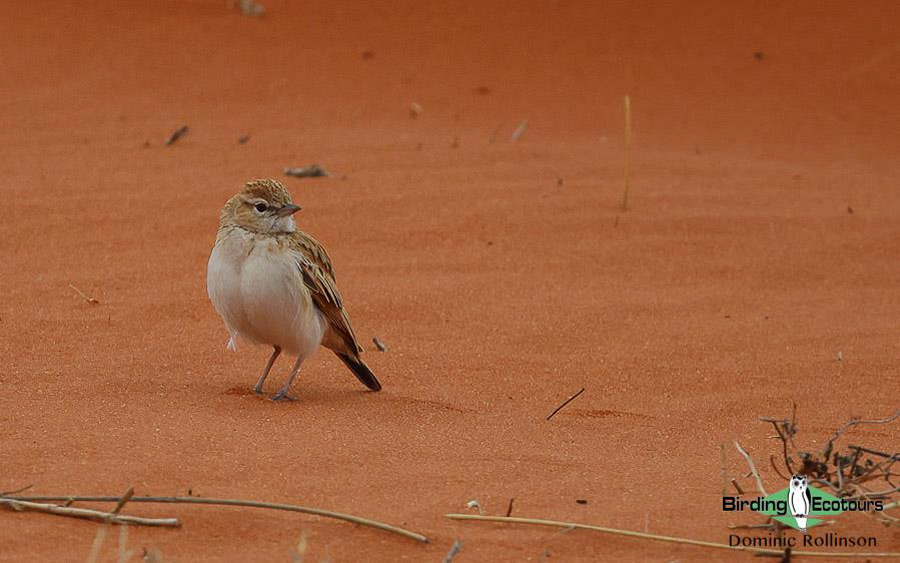
Fawn-colored Larks were seen at the Koa Dunes, alongside Red Larks.
Day 8, 1st September 2023. Pofadder birding
We backtracked a bit today from Pofadder to the Koa Dunes, a long line of vegetated red sand dunes running in a northwest-southeast direction, about 30 kilometers west of the town of Aggeneys. Within minutes of us arriving, we got onto a displaying Red Lark, the main attraction of the Koa Dunes. It took us a few more minutes, but we did eventually get lovely views of another individual walking over the rusty-colored sand dunes and perching up on low bushes. The bird perched alongside an orange-toned Fawn-coloured Lark – a particularly confiding bird, sitting on a fence post and in full song mere meters away. A few other birding highlights from this area included Sociable and Scaly-feathered Weavers, Spike-heeled Lark, Chat Flycatcher, Lark-like Bunting, Pale Chanting Goshawk, Greater Kestrel and Grey-backed Sparrow-Lark,as well as a pair of Steenbok.
Thereafter, we made our way back to Pofadder, stopping on the outskirts of town for Short-toed Rock Thrush.We swiftly connected with a female perched nonchalantly on the fence posts between the houses, later joined by sunbathing White-backed Mousebirds and a foraging White-throated Canary. We paid a visit to a reservoir where Sclater’s Larks are known to drink, where we found more Grey-backed Sparrow-Larks, Yellow Canaries, Scaly-feathered Weavers, Lark-like Buntings and Ring-necked Doves, but unfortunately, no larks. However, we did get a great sighting of a pair of Bat-eared Foxes running in the distance, which is a real treat to see during the daytime. The distant croaking of Karoo Korhaans helped to keep us entertained during the lark stakeout, and we managed to get lovely views of three of these bustards calling a bit further down the road. We also found a pair of lively Yellow-bellied Eremomelas, another Stark’s Lark and a hunting Chat Flycatcher.
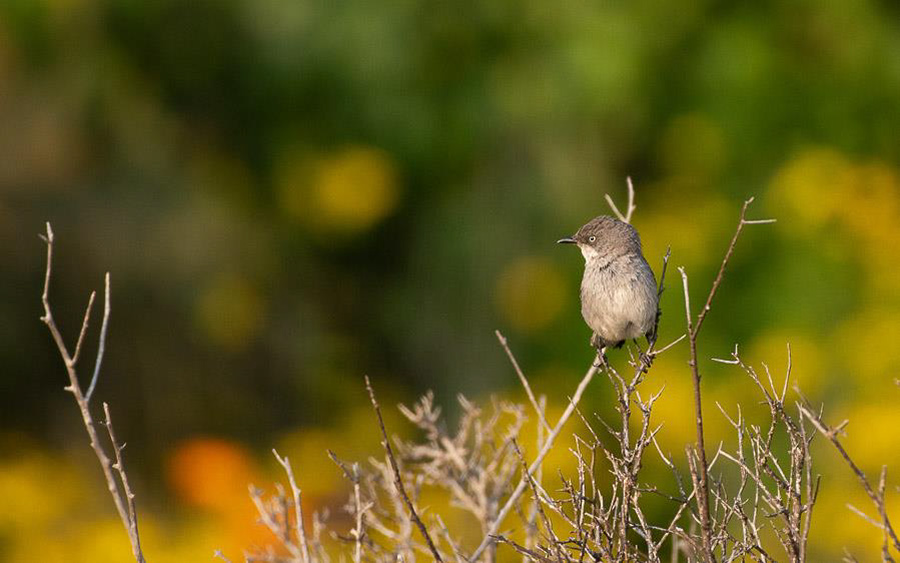
Layard’s Warbler with a backdrop of flowers (photo, tour participant, Jake Zadik).
After lunch and a much-needed rest, we went out again later in the afternoon for a drive towards the border post town of Onseepkans. We didn’t go all the way to the border, but we did manage to eke out a few interesting birds along the first five kilometers of the road, including a pair of Pririt Batises, a Lanner Falcon, a trio of Karoo Korhaans close to the road, our first black morph Mountain Wheatear, Layard’s Warbler, Pale Chanting Goshawk, Dusky Sunbird and Pale-winged Starling.We found two very special reptiles here too: Namaqua Mountain Gecko and Schinz’s Beaked Blind Snake, both localized and rare arid specials. Our third and final visit to the Sclater’s Lark spot garnered nothing new, but two groups of very close Spike-heeled Larks,a Karoo Chat and another pair of Karoo Korhaans were notable sightings.
We also visited the petrol station in Pofadder multiple times during the day (in the hopes of finding Bradfield’s Swift), accumulating a respectable selection of species for this spot, with the usual Rock Martins, Orange River White-eyes, and African Red-eyed Bulbuls,being punctuated by a male Short-toed Rock Thrush, a small group of Black-throated Canaries, a Familiar Chat, Alpine Swifts and, at long last, Bradfield’s Swifts soaring with Little Swifts high above the station.
Later in the evening, we went out on a post-dinner night drive, which treated us to stunning views of an Aardwolf standing in the road, and later, a Bat-eared Fox doing the same thing.
Day 9, 2nd August 2023. Augrabies Falls National Park and transfer to Kgalagadi Lodge
We had a slightly later morning today in order to enjoy a sit-down breakfast at the hotel, but still managed to get some good birding done in the interim. A pair of Bradfield’s Swifts came flying overhead just before breakfast, once again alongside Little Swifts,and the hotel garden’s resident Long-billed Crombecs, Karoo Thrushes, African Red-eyed Bulbuls, White-backed Mousebirds and a visiting Bokmakierie bid us farewell as we departed Pofadder and headed east towards Upington.
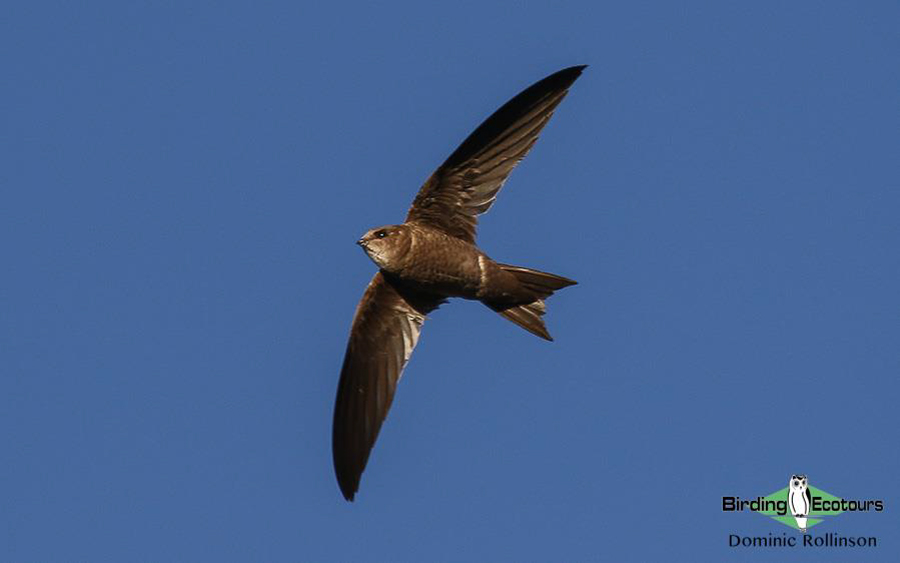
Bradfield’s Swift took some finding but eventually we saw them well in Pofadder.
En route, we made a lengthy detour to Augrabies Falls National Park for lunch, as well as to enjoy the spectacular views of the falls, being greeted by stunning Cape Starlings as we arrived. The campsite held a variety of new species for us, such as Namaqua Warbler, Crested Barbet, Golden-tailed Woodpecker, Brubru, Southern Grey-headed Sparrow and Common Reed Warbler, alongside Cardinal Woodpecker, African Hoopoe, Pririt Batis,flocks of Common Waxbills,the broad-browed western race of Cape Robin-Chat and a troop of Vervet Monkeys.The walk down to the falls delivered Black-chested Prinia, Acacia Pied Barbet, Dusky Sunbird and White-throated Canary,whilst at the lookout point overlooking the waterfall, large numbers of Alpine Swifts were feasting upon the masses of blackflies that had emerged from the river and were swarming around it. Brightly-colored Broadley’s Flat Lizards clung to the flat granite rockfaces surrounding the waterfall, also in pursuit of the blackflies (the males were also in pursuit of females!).
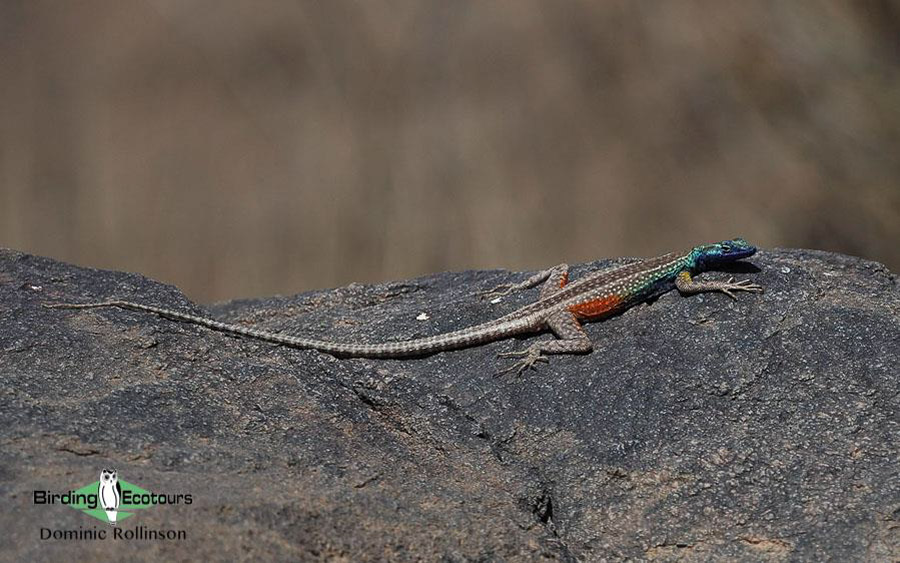
Attractive Broadley’s Flat Lizards were seen at Augrabies Falls National Park.
We managed to pick out other aerial feeders from amongst the Alpine Swifts, including White-throated and Greater Striped Swallows, Brown-throated and Rock Martins, and African Palm, Little and Bradfield’s Swifts.Our best find at Augrabies came in the form of a pair of Black Storks that came gliding high overhead while we were at the waterfall. These storks are resident but not nowhere common in South Africa, so it was great catching up with them here. Down on the river next to the waterfall, we glimpsed the striking African Pied Wagtail (the subspecies here endemic to the Orange River), and the entire reserve was full of Orange River White-eyes and African Red-eyed Bulbuls.
After enjoying lunch back at the park restaurant, where we witnessed tame Pale-winged Starlings scavenging inside the restaurant, we departed the reserve and started on the long drive up to Kgalagadi Lodge, heading through the town of Upington. We had sightings of Northern Black Korhaan, Ant-eating Chat, Lilac-breasted Roller, Kalahari Scrub Robin, Red-crested Korhaan, Southern Yellow-billed Hornbill, Cape Starling, Martial Eagle and Tawny Eagle on the drive up, as well as a large flock of White-backed Vultures on a carcass, accompanied by a few Lappet-faced Vultures.Upon reaching our accommodation, we were greeted by noisy White-browed Sparrow-Weavers drinking from one of the sprinklers. A fabulous dinner and stunning sunset capped off yet another fantastic day on tour.
Day 10, 3rd August 2023. Kgalagadi Transfrontier Park birding and animal viewing
Our earliest breakfast yet was had this morning, allowing us to get to the gate to the Kgalagadi Transfrontier Park at Twee Rivieren by 7 am, in order to meet our safari guide, Ian, who would be taking us out on a six-hour open-top game drive up the Nossob riverbed. This, along with the Auob riverbed, forms the lifeblood of this dry, semi-desert park, as animals and birds are concentrated along its course, attracted by the promise of water, food and shelter from the unforgiving Kalahari sun.
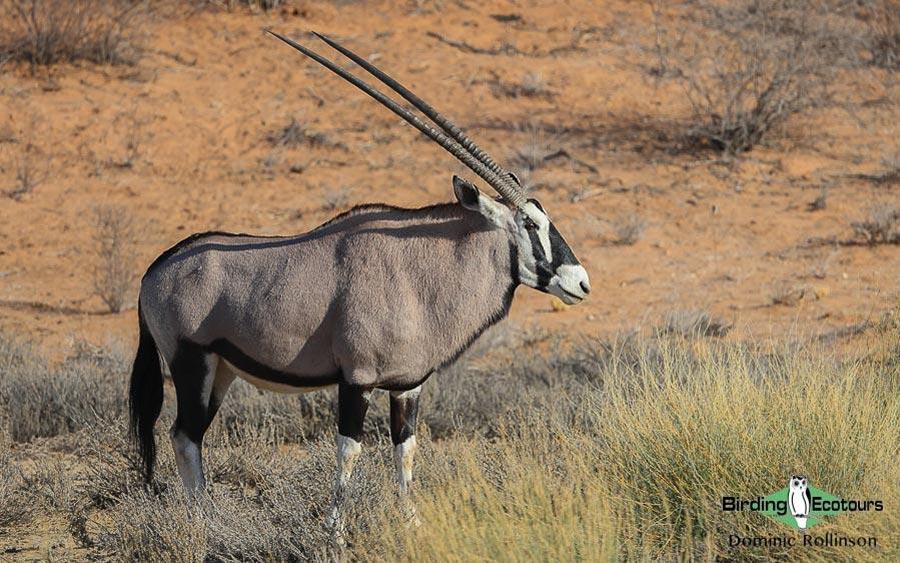
Attractive Gemsbok are abundant in the Kalahari.
The drive started out stunningly, with an African Wild Cat walking past our vehicle while we were still parked at the gate, and being diligently watched by the local birds, including a pair of Groundscraper Thrushes. This was followed by two sleepy Leopards and a very showy Cheetah, presenting themselves within the first ten kilometers of the drive. We also caught up with some of the more common birds in the park along this initial stretch of road, such as White-browed Sparrow-Weaver, Kalahari Scrub Robin, Cape Starling, Fork-tailed Drongo and Marico Flycatcher.Throughout the park, all these species were very common, and we had smaller numbers of Yellow Canary, Black-chested Prinia, Pririt Batis, Chestnut-vented Warbler,the subcoronatus race of Southern Fiscal,the shockingly vivid Crimson-breasted Shrike and the thick-billed western race of Sabota Lark.Decent numbers of Namaqua Sandgrouse were seen flying overhead to their watering points in the early morning, whilst a single male Burchell’s Sandgrouse was seen very well at Kij Kij waterhole, soaking his specialized belly feathers to take water back to his chicks. Other singletons observed in the reserve included Crowned Lapwing, Fawn-coloured Lark, Pearl-breasted Swallow,an unexpected Buffy Pipit,a distant Kori Bustard and a roosting Southern White-faced Owl, expertly spotted at its well-hidden daytime roost by our ranger.
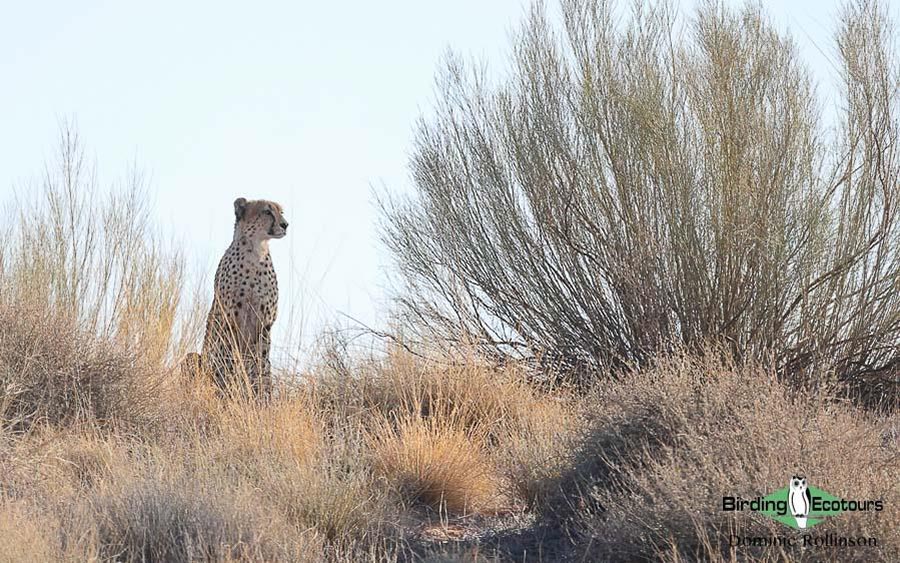
This Cheetah was seen surveying the area from atop a dune in the Kalahari.
Raptors were well-represented here, with many Pale Chanting Goshawks,at least six different Tawny Eagles,a few Gabar Goshawks (including a melanistic bird), a pair of Lanner Falcons, a pair of Martial Eagles and a pair of Rock Kestrels all providing exquisite perched views, whilst a distant kettle of White-backed Vultures was also witnessed. Our lunch stop at Melkvlei picnic site saw us being bombarded by tens of beautiful Cape Starlings coming to scavenge scraps from us, accompanied by Southern Grey-headed Sparrows and White-browed Sparrow-Weavers.
It was also a pleasure to see the many wild Common Ostriches that roam the riverbeds of the park, alongside a variety of game including herds of Springbok and Common (Blue) Wildebeest, and smaller numbers of Gemsbok (Southern Oryx). Other notable mammal sightings included two Slender Mongooses (here much redder than those in the east) and an obliging Honey Badger vigorously digging under a dead tree. These rugged trees are a staple of the Kgalagadi riverbed landscape, and most of the larger ones are adorned by gargantuan Sociable Weaver nests, which may weigh up to a ton and even break some of the main branches under their immense weight.
After having a wonderful time in the park, we headed back to our lodge for a midday break, after which we headed out again to bird the woodlands south of the park. Not much new was seen here, but we did manage to add Pearl-spotted Owlet and Ashy Tit to the trip list, as well as more views of Red-crested and Northern Black Korhaans, White-backed Vulture, Fairy Flycatcher, Southern Yellow-billed Hornbill, Cardinal Woodpecker and Lark-like Bunting.
Day 11, 4th September 2023. Kgalagadi Transfrontier Park birding and animal viewing
We had another wonderful safari drive into the park today, this time going up the other main road in the park that runs northwest from Twee Rivieren along the Auob riverbed. The first stretch of the drive reintroduced us to the same suite of common thornveld birds we saw yesterday, with Ant-eating Chat and South African Shelduck being new additions to our park list. We had a few noteworthy Gabar Goshawk sightings before our first new bird of the trip for the day, a Common Scimitarbill sunning itself on top of a tall camel-thorn. Chat Flycatchers were more common along this riverbed than the Nossob from yesterday, but still never approached the numbers of ubiquitous Marico Flycatchers.
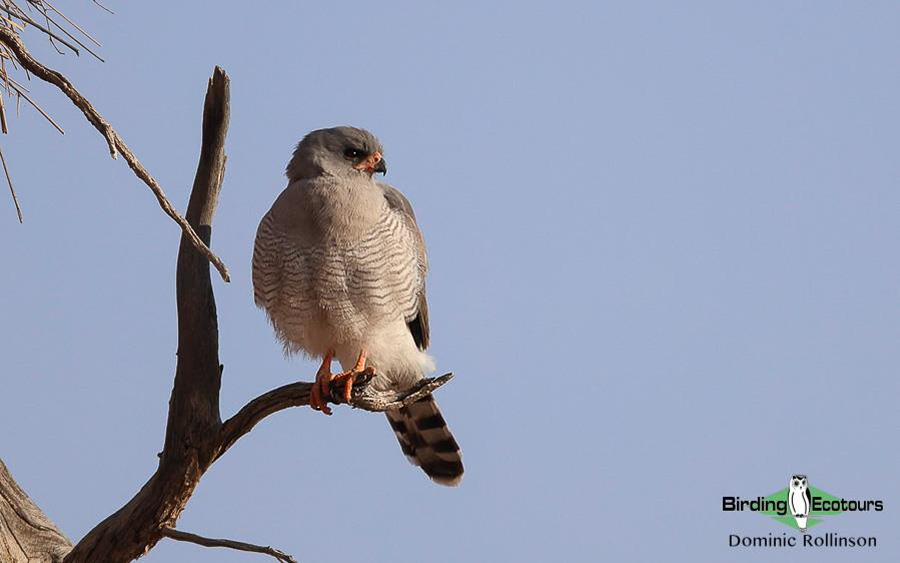
Gabar Goshawk was one of the more abundant raptors seen in the Kalahari.
It also became apparent that Northern Black Korhaans were common along this riverbed, with us getting views of around 15 birds throughout the day. This was contrasted by the relative lack of Pale Chanting Goshawks here, only getting three individuals throughout the day. Tawny Eagles were once again in evidence, with many birds perching up relatively close to the road, allowing for stunning views of this majestic raptor. This was followed by excellent views of yet another Southern White-faced Owl,this time roosting much closer to the road. We soaked in the near-perfect views of the half-asleep owl before moving on and bumping into our next new trip bird soon after, a pair of adorable Pygmy Falcons,with another male being located a few kilometers down the road. We also picked up a lone Greater Striped Swallow here, and Southern Yellow-billed Hornbills became more and more regular from this point on. Further along, we got views of a lone Yellow-bellied Eremomela,after which we started noticing flocks of distant sandgrouse flying overhead to their drinking sites.
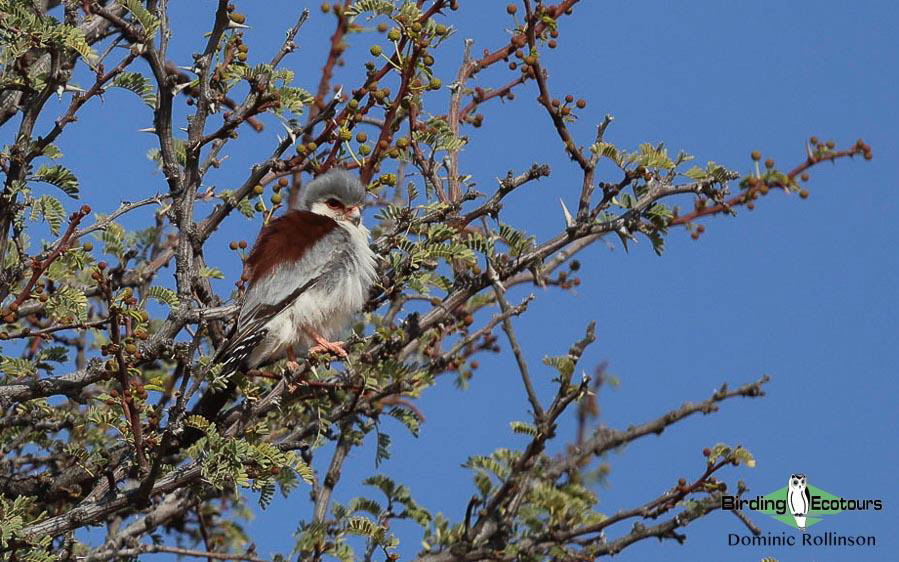
We were all happy to see this attractive Pygmy Falcon in the Kgalagadi Transfrontier Park.
As we approached the Auchterlonie waterhole (picking up an Ashy Tit, Scaly-feathered Weavers and a Cape Crow on the way), we came upon the spectacle of hundreds of Burchell’s Sandgrouse coming down to drink, accompanied by smaller numbers of Namaqua Sandgrouse.We drove around to the Auchterlonie Museum, which has an elevated view of the waterhole, allowing us to perfectly see the sandgrouse flying down, drinking for a few seconds, then taking off and flying right over our heads and off into the desert. A beautiful male Short-toed Rock Thrush perching on the museum ruins was also a welcome distraction from the sandgrouse, and was accompanied by a few Familiar Chats.
We then pushed on towards our lunch stop at Kamqua picnic site, about halfway up the riverbed. Highlights along this section of the drive included a beautiful Purple Roller and a subadult Verreaux’s Eagle-Owl perched in a roadside camel-thorn, as well as a very close pair of Spotted Eagle-Owls roosting right next to the road. Stopping for lunch at Kamqua, we were once again bombarded with scrap-hunting birds, this time the culprits being White-browed Sparrow-Weavers, Sociable Weavers and Ring-necked Doves.The local Familiar Chats were far less intrusive, as was the pair of Karasburg Tree Skinks basking on the dead trees around the picnic site.
After lunch, we started on the long drive back to Twee Rivieren, adding Dusky Sunbird, Acacia Pied Barbet, and a few African Grey Hornbills to our park list, and a gorgeous Black-chested Snake Eagle to our trip list. Mammal sightings in the park today were not to be forgotten, and included a Cheetah a few hundred meters into the reserve, a Honey Badger digging for food in the riverbed, a group of Meerkats foraging and standing guard around their burrows, and a sleepy Cape Fox sitting under a bush on the other side of the riverbed, amongst the never-ending sightings of Springbok, Gemsbok, Common Wildebeest and South African Ground Squirrels.
After getting back to camp around 03:30 p.m., we had a brief break and then went back to Twee Rivieren camp for a quick walk-around, getting us Marico Sunbird, Lark-like Bunting and lovely views of a singing Gabar Goshawk.
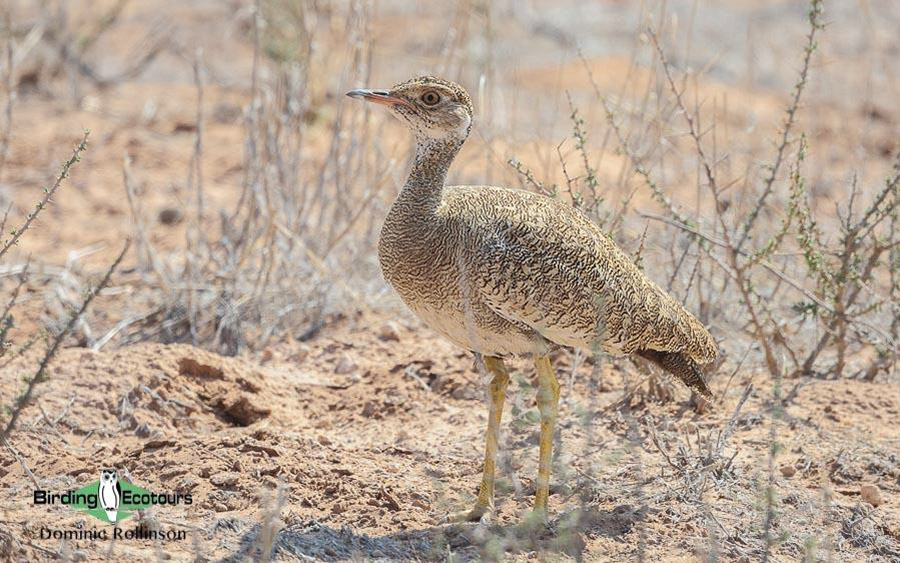
Northern Black Korhaans (such as this female) were numerous in the northern sections of this tour.
Day 12, 5th September 2023. Kgalagadi to Upington
We decided to have a later morning so that we could enjoy a sit-down breakfast and take a walk around the lodge, before packing our bags and starting on the drive back down towards Upington. Birding the open camel-thorn woodlands between the lodge and Askham wasn’t particularly rewarding, as a cold wind had blown in during the night, but we did manage to scratch out a few interesting birds. Here we managed to find Brubru, Cape Starling, African Palm Swift, a brief Martial Eagle flyby, one or two flocks of Namaqua Sandgrouse (including one group sitting in the riverbed next to the road), the usual few White-backed Vultures that nest in the largest trees here, and a Pearl-spotted Owlet calling in the distance.
We headed into the scrubbier plains and dune fields south of Askham. We didn’t do much birding here but caught sight of a few roadside Ant-eating Chats, Northern Black Korhaans and even a few Kori Bustards as we drove.Arriving at our accommodation in Upington, set on the banks of the Orange River, we were greeted by the lodge’s tame Springbok, as well as hundreds of aerial feeders flying around and hawking insects over the water. These consisted mostly of African Palm Swifts and Little Swifts,and Rock and Brown-throated Martins,with Pearl-breasted and White-throated Swallows putting in an occasional appearance. Jake and Juliana even got brief looks at a White-fronted Bee-eater perched on the bottle-brush tree in the center of the front lawn.
We then took a late afternoon drive to the town of Keimoes, 30 minutes east of Upington, also set on the banks of the Orange River. A visit to a random garden in the town turned up the vibrantly-colored Rosy-faced Lovebird,feeding at a bird feeder along with Southern Red Bishops and Red-billed Queleas.The garden also provided us with our second Common Scimitarbill of the trip, as well as White-browed Sparrow-Weavers, African Red-eyed Bulbuls and White-backed Mousebirds.
We then went south of town to the Orange River Bridge, with a spectacular vista overlooking the various channels, sandbars, and reedbeds within and alongside the river. Here, we connected with a plethora of bird species such as African Black Duck, Malachite and Giant Kingfishers, Three-banded Plover, Red-faced Mousebird, African Pied Wagtail, Namaqua Warbler, Black-chested Prinia, Orange River White-eye, Common Reed Warbler, Cape Robin-Chat, Karoo Thrush,our first Hamerkop of the trip, three separate African Fish Eagles (including one flying close by at eye-level) and the same aerial feeder species from the lodge. We then returned to our lodge and enjoyed a tasty dinner after watching the sunset over the western end of the river.
Day 13, 6th September 2023. Upington to Calvinia, Brandvlei birding en route
We enjoyed breakfast at our lodge this morning, followed by some light birding around the riverside garden. This got us Goliath Heron, Brown-hooded Kingfisher, our second Hamerkop of the trip, African Hoopoe, Three-banded Plover, Red-billed Teal and a Crested Barbet calling in the distance, along with the other usual suspects.
After departing our accommodation, we made our way back towards Keimoes, being distracted en route by a pair of Swallow-tailed Bee-eaters sitting on a roadside telephone wire. We then arrived in Keimoes and did some birding along a public dirt road north of town in search of Eastern Clapper and Pink-billed Lark. We had no luck with our primary targets but did find Spike-heeled, Fawn-coloured and Sabota Larks, Northern Black Korhaan, Kalahari Scrub Robin, South African Shelduck and Black-chested Prinia.
We then started on the long drive south to Brandvlei, managing to get another Pygmy Falcon en route. About 10 kilometers north of Brandvlei, we stopped at a water trough next to the road in search of Sclater’s Lark, which we didn’t find here, but the leaking reservoir did attract White-throated Canary, Cape Sparrow, Lark-like Bunting, Red-headed Finch and a single Namaqua Dove.We moved on to another spot east of Brandvlei to keep trying for the larks, once again at a water trough. The drive there produced Northern Black Korhaan, Namaqua Sandgrouse,and a lone Black-eared Sparrow-Lark.Upon arriving at the trough, a small brown bird had just landed next to a puddle alongside the reservoir. A brief glance at it through the binoculars revealed it to be a Sclater’s Lark,which then flew across the road and landed on a trough on the other side of the car. It drank for a few minutes and then took off and flew for miles until it was out of sight. We exchanged high fives and were relieved not to have to sit and wait at any more drinking troughs.
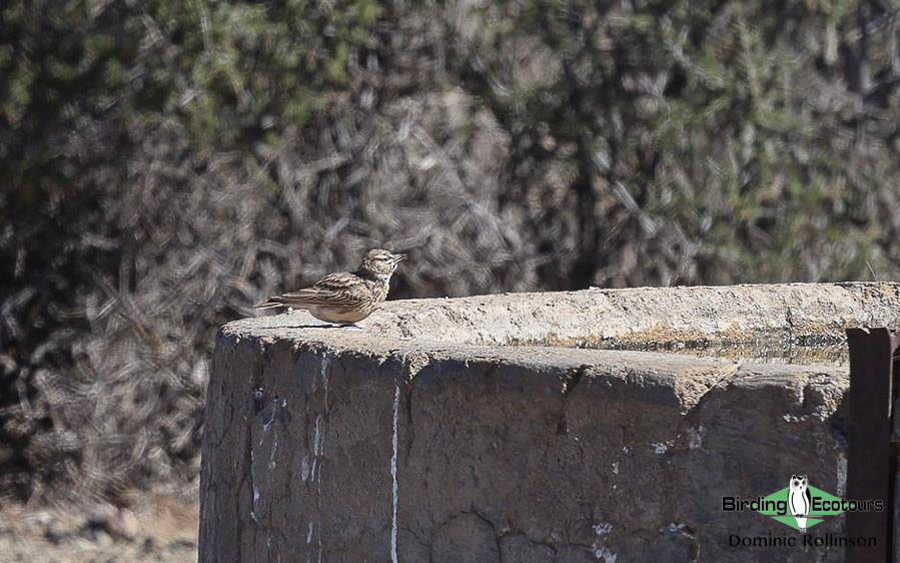
A record shot of the Sclater’s Lark which we saw near Brandvlei.
Driving back from the trough, we managed to find another Karoo Korhaan before reaching Brandvlei and then turning south towards our overnight stop in Calvinia. Along the way, we noticed the slowly increasing numbers of flowers growing along the roadside and managed to score a few interesting birds at a couple of roadside stops, including Sickle-winged Chat, South African Shelduck, Spike-heeled Lark, Mountain Wheatear, Pale-winged Starling, Black-winged Kite and a stunning Double-banded Courser right next to the road. We also found a small group of Namaqua Sandgrouse right on the road verge at one of these stops.
We then came upon a massive dam about 40 kilometers north of Calvinia, which held a plethora of waterbird species, including waders like Little Stint, Common Greenshank, Ruff, Kittlitz’s Plover, Three-banded Plover and Black-winged Stilt,and ducks including Cape and Red-billed Teals,lots of Maccoa Ducks and a surprising pair of White-backed Ducks. The latter was a totally unexpected rarity in this area considering it is a subtropical species that favors waterbodies with aquatic vegetation.
Upon our arrival in Calvinia, we were greeted by a confiding Acacia Pied Barbet and the first Cape White-eyes we’d seen in a little while (since we had been in Orange River White-eye country for the last five days).
Day 14, 7th September 2023.Calvinia birding and transfer to Lambert’s Bay
After a lovely breakfast, we checked out and paid a quick visit to Akkerendam Nature Reserve, situated on the south side of town and encompassing the northern side of the immense Hantamsberg Mountain. It was here where we finally managed to get good views of a couple of Black-headed Canaries feeding on the lower slopes just after the entrance gate, along with close views of Karoo Long-billed Lark and Sickle-winged Chat.Other good birds seen here included South African Shelduck, Layard’s Warbler, Alpine Swift, Pale-winged Starling, White-throated Canary, Karoo Scrub Robin and a pair of Verreaux’s Eagles soaring above the cliffs with their recently fledged offspring.
We then departed Calvinia and drove through towards Nieuwoudtville.We stopped briefly alongside the Nieuwoudtville Wildflower Reserve to admire some of the blooms from the roadside, enjoying two Ludwig’s Bustards flying over the road and the sound of Cape Clapper Larks, Large-billed Larks and Common Quail singing away around us. Passing Nieuwoudtville, we also took a moment to enjoy the breathtaking views from Van Rhyn’s Pass, which drops off from the Bokkeveld plateau onto the Knersvlakte below. At this viewpoint, we got reacquainted with some birds we had left behind in the Cape, such as Cape Canary, Cape Bulbul and Swee Waxbills,and added two surprise trip birds in the form of a Rufous-breasted Sparrowhawk and a group of White-rumped Swifts both flying overhead. Once we reached the bottom of the pass, we pressed on towards Vanrhynsdorp, making a brief stop at the Bagdad Cafe en route to spot the Cape Starlings which hang around here – quite a rare bird in the Western Cape.
After a quick lunch in Clanwilliam, we headed through to the coastal town of Lambert’s Bay where, after checking in to our stunning beachfront accommodation, we paid a visit to the well-known Cape Gannet colony on Bird Island. Located in the bay itself and connected to the mainland by a concrete walkway, this colony is the only publicly accessible Cape Gannet colony in the world, and is quite a popular attraction. This spot allowed us to indulge in the sight of thousands of these beautiful seabirds closely packed together, performing their goofy display antics and squabbling amongst themselves, as well as birds swirling over the island in a vortex as they come and go from fishing trips out to sea. The island is said to support about 15,000 gannets, and is one of only six breeding colonies of Cape Gannet in the world. There is also a large Afro-Australian Fur Seal colony on the rocks beyond the island, and these large seals take advantage of the gannet colony to hunt their fledglings as they leave the nest. After we’d had our fill of the gannets, we went back to our guesthouse and relaxed for the rest of the afternoon, enjoying a fiery sunset over the ocean and a lovely beachside dinner to cap off our last night of the tour.
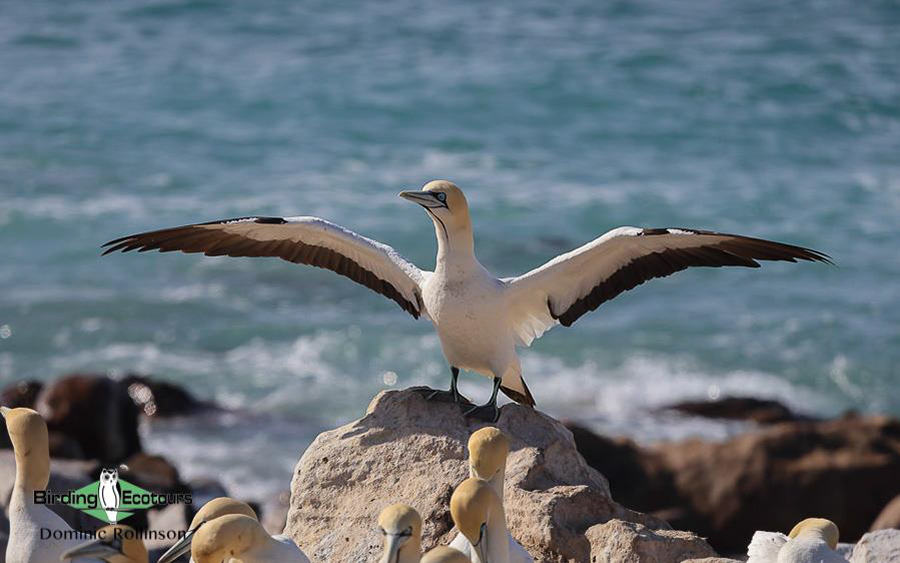
We had lovely looks at thousands of Cape Gannets in Lambert’s Bay.
Day 15, 8th September 2023. Transfer to Cape Town and departure
Today was mostly a travel day, driving back from Lambert’s Bay to Cape Town, but we did manage to squeeze in some birding stops along the way. Driving south towards Elands Bay, a quick look out over the expansive Verlorenvlei just east of town provided us with a few waterbirds, such as Great Crested Grebe and Cape and Red-billed Teals. The karroid scrub on the surrounding rocky hills closer to town was alive with both birds and flowers. Species seen here included Rock Kestrel, Mountain Wheatear, Grey Tit, Fairy Flycatcher, Long-billed Crombec, Layard’s Warbler, Grey-backed Cisticola, Cape Bunting and Pin-tailed Whydah.
Roadside birding along the way south, passing Velddrif and Dwarskersbos, got us Jackal Buzzard, Pale Chanting Goshawk, Blue Crane, Black-winged Stilt and Banded Martin.We then turned off the main west coast road and took an amble down the Darling Hills road into the Swartland farmlands, inland of the west coast. Along these quieter backroads, we found Great White Pelican, Namaqua Dove, Little Rush Warbler, Lesser Swamp Warbler, Yellow Bishop, Bokmakierie, Long-billed Crombec and Blue Crane,amongst other common species.
We then dropped off Kathleen and Ron at the airport, before shooting out to Strandfontein Sewage Works for a quick whizz around, which added the likes of Southern Pochard and Fulvous Whistling Duck while the drive back to the airport added a House Crow – our final new bird for the trip. This then ended a thoroughly enjoyable and productive two weeks in western South Africa with fantastic floral displays and some top-notch bird and mammal sightings. Thanks to all the participants for making this tour the success it was.
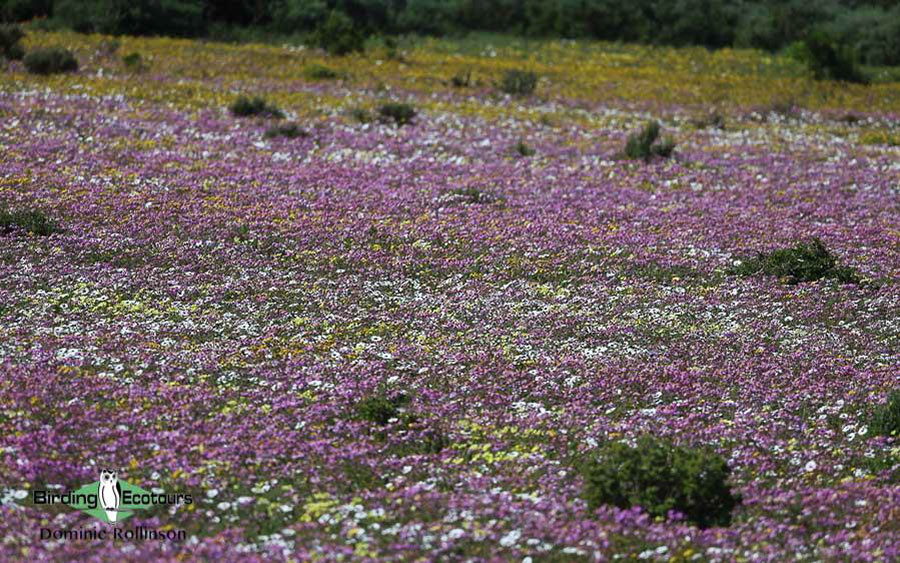
The fantastic floral displays were a major highlight of this tour.
Bird List – Following IOC (12.1)
Birds ‘heard only’ are marked with (H) after the common name, birds seen by the guide only are marked with a (G) after the common name, all other species were seen both by clients and guide.
The following notation after species names is used to show conservation status following BirdLife International. CR = Critically Endangered, EN = Endangered, VU = Vulnerable.
| Common Name | Scientific Name |
| Ostriches (Struthionidae) | |
| Common Ostrich | Struthio camelus |
| Ducks, Geese, Swans (Anatidae) | |
| Fulvous Whistling Duck | Dendrocygna bicolor |
| White-backed Duck | Thalassornis leuconotus |
| Spur-winged Goose | Plectropterus gambensis |
| Knob-billed Duck | Sarkidiornis melanotos |
| Egyptian Goose | Alopochen aegyptiaca |
| South African Shelduck | Tadorna cana |
| African Pygmy Goose | Nettapus auritus |
| Blue-billed Teal | Spatula hottentota |
| Cape Shoveler | Spatula smithii |
| African Black Duck | Anas sparsa |
| Yellow-billed Duck | Anas undulata |
| Cape Teal | Anas capensis |
| Red-billed Teal | Anas erythrorhyncha |
| Southern Pochard | Netta erythrophthalma |
| Maccoa Duck – VU | Oxyura maccoa |
| Guineafowl (Numididae) | |
| Helmeted Guineafowl | Numida meleagris |
| Pheasants & Allies (Phasianidae) | |
| Grey-winged Francolin | Scleroptlia afra |
| Common Quail | Coturnix xoturnix |
| Cape Spurfowl | Pternistis capensis |
| Nightjars (Caprimulgidae) | |
| Fiery-necked Nightjar | Caprimulgus pectoralis |
| Freckled Nightjar | Caprimulgus tristigma |
| Swifts (Apodidae) | |
| African Palm Swift | Cypsiurus parvus |
| Alpine Swift | Tachymarptis melba |
| African Black Swift | Apus barbatus |
| Bradfield’s Swift | Apus bradfieldi |
| Little Swift | Apus affinis |
| White-rumped Swift | Apus caffer |
| Bustards (Otididae) | |
| Kori Bustard | Ardeotis kori |
| Ludwig’s Bustard – EN | Neotis ludwigii |
| Karoo Korhaan | Eupodotis vigorsii |
| Red-crested Korhaan | Lophotis ruficrista |
| Southern Black Korhaan – VU | Afrotis afra |
| Northern Black Korhaan | Afrotis afraoides |
| Sandgrouse (Pteroclidae) | |
| Namaqua Sandgrouse | Pterocles namaqua |
| Burchell’s Sandgrouse | Pterocles burchelli |
| Pigeons, Doves (Columbidae) | |
| Rock Dove | Columba livia |
| Speckled Pigeon | Columba guinea |
| African Olive Pigeon | Columba arquatrix |
| Red-eyed Dove | Streptopelia semitorquata |
| Ring-necked Dove | Streptopelia capicola |
| Laughing Dove | Spilopelia senegalensis |
| Namaqua Dove | Oena capensis |
| Flufftails (Sarothruridae) | |
| Buff-spotted Flufftail | Sarothrura elegans |
| Rails, Crakes & Coots (Rallidae) | |
| African Rail | Rallus caerulescens |
| Common Moorhen | Gallinula chloropus |
| Red-knobbed Coot | Fulica cristata |
| African Swamphen | Porphyrio madagascariensis |
| Cranes (Gruidae) | |
| Blue Crane – VU | Grus paradisea |
| Grebes (Podicipedidae) | |
| Little Grebe | Tachybaptus ruficollis |
| Great Crested Grebe | Podiceps cristatus |
| Black-necked Grebe | Podiceps nigricollis |
| Flamingos (Phoenicopteridae) | |
| Greater Flamingo | Phoenicopterus roseus |
| Lesser Flamingo | Phoeniconaias minor |
| Stone-curlews, Thick-knees (Burhinidae) | |
| Spotted Thick-knee | Burhinus capensis |
| Oystercatchers (Haematopodidae) | |
| African Oystercatcher | Haematopus moquini |
| Stilts, Avocets (Recurvirostridae) | |
| Black-winged Stilt | Himantopus himantopus |
| Pied Avocet | Recurvirostra avosetta |
| Plovers (Charadriidae) | |
| Blacksmith Lapwing | Vanellus armatus |
| Crowned Lapwing | Vanellus coronatus |
| Grey Plover | Pluvialis squatarola |
| Kittlitz’s Plover | Charadrius pecuarius |
| Three-banded Plover | Charadrius tricollaris |
| White-fronted Plover | Charadrius marginatus |
| Chestnut-banded Plover | Charadrius pallidus |
| Sandpipers, Snipes (Scolopacidae) | |
| Eurasian Whimbrel | Numenius phaeopus |
| Eurasian Curlew | Numenius arquata |
| Bar-tailed Godwit | Limosa lapponica |
| Ruddy Turnstone | Arenaria interpres |
| Red Knot | Calidris canutus |
| Ruff | Calidris pugnax |
| Curlew Sandpiper | Calidris ferruginea |
| Little Stint | Calidris minuta |
| Terek Sandpiper | Xenus cinereus |
| Red-necked Phalarope | Phalaropus lobatus |
| Common Sandpiper | Actitis hypoleucos |
| Common Greenshank | Tringa nebularia |
| Coursers, Pratincoles (Glareolidae) | |
| Burchell’s Courser | Cursorius rufus |
| Double-banded Courser | Rhinoptilus africanus |
| Gulls, Terns, Skimmers (Laridae) | |
| Grey-headed Gull | Chroicocephalus cirrocephalus |
| Hartlaub’s Gull | Chroicocephalus hartlaubii |
| Kelp Gull | Larus dominicanus |
| Caspian Tern | Hydroprogne caspia |
| Greater Crested Tern | Thalasseus bergii |
| Sandwich Tern | Thalasseus sandvicensis |
| Common Tern | Sterna hirundo |
| Antarctic Tern | Sterna vittata |
| Skuas (Stercorariidae) | |
| Brown Skua | Stercorarius antarcticus |
| Penguins (Spheniscidae) | |
| African Penguin – EN | Spheniscus demersus |
| Albatrosses (Diomedeidae) | |
| Shy Albatross | Thalassarche cauta |
| Petrels, Shearwaters, Diving Petrels (Procellariidae) – 2 / 101 | |
| White-chinned Petrel – VU | Procellaria aequinoctialis |
| Sooty Shearwater | Ardenna grisea |
| Storks (Ciconiidae) | |
| Black Stork | Ciconia nigra |
| Gannets, Boobies (Sulidae) | |
| Cape Gannet – EN | Morus capensis |
| Anhingas, Darters (Anhingidae) | |
| African Darter | Anhinga rufa |
| Cormorants, Shags (Phalacrocoracidae) | |
| Reed Cormorant | Microcarbo africanus |
| Crowned Cormorant | Microcarbo coronatus |
| Bank Cormorant – EN | Phalacrocorax neglectus |
| Cape Cormorant – EN | Phalacrocorax capensis |
| White-breasted Cormorant | Phalacrocorax lucidus |
| Ibises, Spoonbills (Threskiornithidae) | |
| African Sacred Ibis | Threskiornis aethiopicus |
| Hadada Ibis | Bostrychia hagedash |
| Glossy Ibis | Plegadis falcinellus |
| African Spoonbill | Platalea alba |
| Herons, Bitterns (Ardeidae) | |
| Black-crowned Night Heron | Nycticorax nycticorax |
| Western Cattle Egret | Bubulcus ibis |
| Grey Heron | Ardea cinerea |
| Black-headed Heron | Ardea melanocephala |
| Goliath Heron | Ardea goliath |
| Purple Heron | Ardea purpurea |
| Little Egret | Egretta garzetta |
| Hamerkop (Scopidae) | |
| Hamerkop | Scopus umbretta |
| Pelicans (Pelecanidae) | |
| Great White Pelican | Pelecanus onocrotalus |
| Pink-backed Pelican | Pelecanus rufescens |
| Kites, Hawks, Eagles (Accipitridae) | |
| Black-winged Kite | Elanus caeruleus |
| African Harrier-Hawk | Polyboroides typus |
| White-backed Vulture – CR | Gyps africanus |
| Lappet-faced Vulture – CR | Torgos tracheliotos |
| Black-chested Snake Eagle | Circaetus pectoralis |
| Martial Eagle – EN | Polemaetus bellicosus |
| Booted Eagle | Hieraaetus pennatus |
| Tawny Eagle – VU | Aquila rapax |
| Verreaux’s Eagle | Aquila verreauxii |
| Gabar Goshawk | Micronisus gabar |
| Pale Chanting Goshawk | Melierax canorus |
| Rufous-breasted Sparrowhawk | Accipiter rufiventris |
| Black Sparrowhawk | Accipiter melanoleucus |
| African Marsh Harrier | Circus ranivorus |
| Black Harrier – EN | Circus maurus |
| Yellow-billed Kite | Milvus aegyptius |
| African Fish Eagle | Haliaeetus vocifer |
| Common Buzzard | Buteo buteo |
| Jackal Buzzard | Buteo rufofuscus |
| Owls (Strigidae) | |
| Pearl-spotted Owlet | Glaucidium perlatum |
| Southern White-faced Owl | Ptilopsis granti |
| Spotted Eagle-Owl | Bubo africanus |
| Verreaux’s Eagle-Owl | Bubo lacteus |
| Mousebirds (Coliidae) | |
| Speckled Mousebird | Colius striatus |
| White-backed Mousebird | Colius colius |
| Red-faced Mousebird | Urocolius indicus |
| Hoopoes (Upupidae) | |
| African Hoopoe | Upupa africana |
| Wood Hoopoes (Phoeniculidae) | |
| Common Scimitarbill | Rhinopomastus cyanomelas |
| Hornbills (Bucerotidae) | |
| Southern Yellow-billed Hornbill | Tockus leucomelas |
| African Grey Hornbill | Lophoceros nasutus |
| Rollers (Coraciidae) | |
| Purple Roller | Coracias naevius |
| Lilac-breasted Roller | Coracias caudatus |
| Kingfishers (Alcedinidae) | |
| Brown-hooded Kingfisher | Halcyon albiventris |
| Malachite Kingfisher | Corythornis cristatus |
| Giant Kingfisher | Megaceryle maxima |
| Pied Kingfisher | Ceryle rudis |
| Bee-eaters (Meropidae) | |
| Swallow-tailed Bee-eater | Merops hirundineus |
| White-fronted Bee-eater | Merops bullockoides |
| African Barbets (Lybiidae) | |
| Acacia Pied Barbet | Tricholaema leucomelas |
| Crested Barbet | Trachyphonus vaillantii |
| Honeyguides (Indicatoridae) | |
| Brown-backed Honeybird | Prodotiscus regulus |
| Woodpeckers (Picidae) | |
| Ground Woodpecker | Geocolaptes olivaceus |
| Golden-tailed Woodpecker | Campethera abingoni |
| Cardinal Woodpecker | Dendropicos fuscescens |
| Olive Woodpecker | Dendropicos griseocephalus |
| Caracaras, Falcons (Falconidae) | |
| Pygmy Falcon | Polihierax semitorquatus |
| Rock Kestrel | Falco rupicolus |
| Greater Kestrel | Falco rupicoloides |
| Lanner Falcon | Falco biarmicus |
| Peregrine Falcon | Falco peregrinus |
| Old World Parrots (Psittaculidae) | |
| Rosy-faced Lovebird | Agapornis roseicollis |
| Wattle-eyes, Batises (Platysteiridae) | |
| Cape Batis | Batis capensis |
| Pririt Batis | Batis pririt |
| Bushshrikes (Malaconotidae | |
| Bokmakierie | Telophorus zeylonus |
| Southern Boubou | Laniarius ferrugineus |
| Crimson-breasted Shrike | Laniarius atrococcineus |
| Brubru | Nilaus afer |
| Shrikes (Laniidae) | |
| Southern Fiscal | Lanius collaris |
| Drongos (Dicruridae) | |
| Fork-tailed Drongo | Dicrurus adsimilis |
| Crows, Jays (Corvidae) | |
| House Crow | Corvus splendens |
| Cape Crow | Corvus capensis |
| Pied Crow | Corvus albus |
| White-necked Raven | Corvus albicollis |
| Rockjumpers (Chaetopidae) | |
| Cape Rockjumper | Chaetops frenatus |
| Fairy Flycatchers (Stenostiridae) | |
| Fairy Flycatcher | Stenostira scita |
| Tits, Chickadees (Paridae) | |
| Ashy Tit | Melaniparus cinerascens |
| Grey Tit | Melaniparus afer |
| Penduline Tits (Remizidae) | |
| Cape Penduline Tit | Anthoscopus minutus |
| Larks (Alaudidae) | |
| Spike-heeled Lark | Chersomanes albofasciata |
| Karoo Long-billed Lark | Certhilauda subcoronata |
| Cape Long-billed Lark | Certhilauda curvirostris |
| Black-eared Sparrow-Lark | Eremopterix australis |
| Grey-backed Sparrow-Lark | Eremopterix verticalis |
| Sabota Lark | Calendulauda sabota |
| Fawn-colored Lark | Calendulauda africanoides |
| Karoo Lark | Calendulauda albescens |
| Red Lark – VU | Calendulauda burra |
| Barlow’s Lark | Calendulauda barlowi |
| Cape Clapper Lark | Mirafra apiata |
| Sclater’s Lark | Spizocorys sclateri |
| Stark’s Lark | Spizocorys starki |
| Large-billed Lark | Galerida magnirostris |
| Red-capped Lark | Calandrella cinerea |
| Bulbuls (Pycnonotidae) | |
| Sombre Greenbul | Andropadus importunus |
| African Red-eyed Bulbul | Pycnonotus nigricans |
| Cape Bulbul | Pycnonotus capensis |
| Swallows, Martins (Hirundinidae) | |
| Banded Martin | Neophedina cincta |
| Brown-throated Martin | Riparia paludicola |
| Rock Martin | Ptyonoprogne fuligula |
| Pearl-breasted Swallow | Hirundo dimidiata |
| White-throated Swallow | Hirundo albigularis |
| Greater Striped Swallow | Cecropis cucullata |
| Crombecs, African Warblers (Macrosphenidae) | |
| Cape Grassbird | Sphenoeacus afer |
| Long-billed Crombec | Sylvietta rufescens |
| Victorin’s Warbler | Cryptillas victorini |
| Reed Warblers & Allies (Acrocephalidae) | |
| Lesser Swamp Warbler | Acrocephalus gracilirostris |
| Common Reed Warbler | Acrocephalus scirpaceus |
| Grassbirds & Allies (Locustellidae) | |
| Little Rush Warbler | Bradypterus baboecala |
| Cisticolas & Allies (Cisticolidae) | |
| Grey-backed Cisticola | Cisticola subruficapilla |
| Levaillant’s Cisticola | Cisticola tinniens |
| Neddicky | Cisticola fulvicapilla |
| Cloud Cisticola | Cisticola textrix |
| Black-chested Prinia | Prinia flavicans |
| Karoo Prinia | Prinia maculosa |
| Namaqua Warbler | Phragmacia substriata |
| Bar-throated Apalis | Apalis thoracica |
| Rufous-eared Warbler | Malcorus pectoralis |
| Cinnamon-breasted Warbler | Euryptila subcinnamomea |
| Yellow-bellied Eremomela | Eremomela icteropygialis |
| Karoo Eremomela | Eremomela gregalis |
| Sylviid Babblers (Sylviidae) | |
| Layard’s Warbler | Curruca layardi |
| Chestnut-vented Warbler | Curruca subcoerulea |
| White-eyes (Zosteropidae) | |
| Orange River White-eye | Zosterops pallidus |
| Cape White-eye | Zosterops virens |
| Sugarbirds (Promeropidae) | |
| Cape Sugarbird | Promerops cafer |
| Starlings, Rhabdornis (Sturnidae) | |
| Common Myna | Acridotheres tristis |
| Common Starling | Sturnus vulgaris |
| Wattled Starling | Creatophora cinerea |
| Cape Starling | Lamprotornis nitens |
| Pied Starling | Lamprotornis bicolor |
| Red-winged Starling | Onychognathus morio |
| Pale-winged Starling | Onychognathus nabouroup |
| Thrushes (Turdidae) | |
| Groundscraper Thrush | Turdus litsitsirupa |
| Olive Thrush | Turdus olivaceus |
| Karoo Thrush | Turdus smithi |
| Chats, Old World Flycatchers (Muscicapidae) | |
| Karoo Scrub Robin | Cercotrichas coryphoeus |
| Kalahari Scrub Robin | Cercotrichas paena |
| Chat Flycatcher | Melaenornis infuscatus |
| Marico Flycatcher | Melaenornis mariquensis |
| Fiscal Flycatcher | Melaenornis silens |
| African Dusky Flycatcher | Muscicapa adusta |
| Cape Robin-Chat | Cossypha caffra |
| Cape Rock Thrush | Monticola rupestris |
| Short-toed Rock Thrush | Monticola brevipes |
| African Stonechat | Saxicola torquatus |
| Sickle-winged Chat | Emarginata sinuata |
| Karoo Chat | Emarginata schlegelii |
| Tractrac Chat | Emarginata tractrac |
| Ant-eating Chat | Myrmecocichla formicivora |
| Mountain Wheatear | Myrmecocichla monticola |
| Capped Wheatear | Oenanthe pileata |
| Familiar Chat | Oenanthe familiaris |
| Sunbirds (Nectariniidae) | |
| Orange-breasted Sunbird | Anthobaphes violacea |
| Amethyst Sunbird | Chalcomitra amethystina |
| Malachite Sunbird | Nectarinia famosa |
| Southern Double-collared Sunbird | Cinnyris chalybeus |
| Marico Sunbird | Cinnyris mariquensis |
| Dusky Sunbird | Cinnyris fuscus |
| Old World Sparrows, Snowfinches (Passeridae) | |
| Cape Sparrow | Passer melanurus |
| Southern Grey-headed Sparrow | Passer diffusus |
| House Sparrow | Passer domesticus |
| Weavers, Widowbirds (Ploceidae) | |
| White-browed Sparrow-Weaver | Plocepasser mahali |
| Sociable Weaver | Philetairus socius |
| Scaly-feathered Weaver | Sporopipes squamifrons |
| Cape Weaver | Ploceus capensis |
| Southern Masked Weaver | Ploceus velatus |
| Red-billed Quelea | Quelea quelea |
| Southern Red Bishop | Euplectes orix |
| Yellow Bishop | Euplectes capensis |
| Waxbills, Munias & Allies (Estrildidae) | |
| Bronze Mannikin | Spermestes cucullata |
| Swee Waxbill | Coccopygia melanotis |
| Common Waxbill | Estrilda astrild |
| Red-headed Finch | Amadina erythrocephala |
| Indigobirds, Whydahs (Viduidae) | |
| Pin-tailed Whydah | Vidua macroura |
| Shaft-tailed Whydah | Vidua regia |
| Wagtails, Pipits (Motacillidae) | |
| Cape Wagtail | Motacilla capensis |
| African Pied Wagtail | Motacilla aguimp |
| Cape Longclaw | Macronyx capensis |
| African Pipit | Anthus cinnamomeus |
| Nicholson’s Pipit | Anthus nicholsoni |
| Buffy Pipit | Anthus vaalensis |
| Finches, Euphonias (Fringillidae) | |
| Common Chaffinch | Fringilla coelebs |
| Forest Canary | Crithagra scotops |
| Black-throated Canary | Crithagra atrogularis |
| Cape Siskin | Crithagra totta |
| Yellow Canary | Crithagra flaviventris |
| Brimstone Canary | Crithagra sulphurata |
| White-throated Canary | Crithagra albogularis |
| Protea Canary | Crithagra leucoptera |
| Cape Canary | Serinus canicollis |
| Black-headed Canary | Serinus alario |
| Buntings (Emberizidae) | |
| Lark-like Bunting | Emberiza impetuani |
| Species Seen | 292 |
| Species heard only | 3 |
| Species seen by guide only | 1 |
| Total species recorded | 296 |
Mammal List
The following notation after species names is used to show conservation status following the IUCN Red List: VU = Vulnerable.
| Common Name | Scientific Name |
| Hyraxes (Procaviidae) | |
| Rock Hyrax | Procavia capensis |
| Rabbits and Hares (Leporidae) | |
| Cape Hare | Lepus capensis |
| Dassie Rats (Petromuridae) | |
| Dassie Rat | Petromus typicus |
| Squirrels and Relatives (Sciuridae) | |
| South African Ground Squirrel | Xerus inauris |
| Eastern Grey Squirrel | Sciurus carolinensis |
| Old World Mice, Rats and Gerbils (Muridae) | |
| Four-striped Mouse | Rhabdomys pumilio |
| Karoo Bush Rat | Myotomys unisulcatus |
| Old World Monkeys (Cercopithecidae) | |
| Chacma Baboon | Papio ursinus |
| Vervet | Chlorocebus pygerythrus |
| Cats (Felidae) | |
| Wild Cat | Felis lybica |
| Cheetah | Acinonyx jubatus |
| Leopard – VU | Panthera pardus |
| Mongooses and Fossa (Herpestidae) | |
| Yellow Mongoose | Cynictis penicillata |
| Cape Grey Mongoose | Herpestes pulverulentus |
| Slender Mongoose | Herpestes sanguineus |
| Meerkat | Suricata suricatta |
| Canids (Canidae) | |
| Black-backed Jackal | Lupulella mesomelas |
| Cape Fox | Vulpes chama |
| Bat-eared Fox | Otocyon megalotis |
| Eared Seals (Otariidae) | |
| Afro-Australian Fur Seal | Arctocephalus pusillus |
| Mustelids (Mustelidae) | |
| African Clawless Otter | Aonyx capensis |
| Honey Badger | Mellivora capensis |
| Horses, Asses and Zebras (Equidae) | |
| (Cape) Mountain Zebra – VU | Equus zebra |
| Bovids (Bovidae) | |
| Common Eland | Tragelaphus oryx |
| Gemsbok | Oryx gazella |
| Common (Blue) Wildebeest | Connochaetes taurinus |
| Blesbok (Bontebok) | Damaliscus pygargus |
| Springbok | Antidorcas marsuplialis |
| Steenbok | Raphicerus campestris |
| Cape Grysbok | Raphicerus melanotis |
| Oceanic dolphins (Delphinidae) | |
| Heaviside’s Dolphin | Caphalorhynchus heavidii |
| Total species seen: | 31 |
Reptile List
| Common Name | Scientific Name |
| Tortoises (Testudinidae) | |
| Angulate Tortoise | Chersina angulata |
| Psammophiidae | |
| Spotted Skaapsteker | Psammophylax rhombeatus |
| Pseudaspididae | |
| Mole Snake | Pseudaspis cana |
| Blind snakes (Typhlopidae) | |
| Schinz’s Beaked Blind Snake | Rhinotyphlops schinzi |
| True lizards (Lacertidae) | |
| Namaqua Sand Lizard | Pedioplanis namaquensis |
| Plain Sand Lizard | Pedioplanis inornata |
| Spinytail lizards (Cordylidae) | |
| Karoo Girdled Lizard | Karusasaurus polyzonus |
| Broadley’s Flat Lizard | Platysaurus broadleyi |
| Skinks (Scincidae) | |
| Varieagated Skink | Trachylepis variegata |
| Red-sided Skink | Trachylepis homalocephala |
| Western Three-striped Skink | Trachylepis occidentalis |
| Karasburg Tree Skink | Trachylepis sparsa |
| Agamas (Agamidae) | |
| Southern Rock Agama | Agama atra |
| Chameleons (Chamaeleonidae) | |
| Namaqua Dwarf Chameleon | Bradypodion occidentale |
| Geckos (Gekkonidae) | |
| Bibron’s Gecko | Chondrodactylus bibronii |
| Namaqua Mountain Gecko | Pachydactylus montanus |
| Total species seen: | 16 |
Frog List
Frogs ‘heard only’ are marked with (H) after the common name.
| Common Name | Scientific Name |
| True toads (Bufonidae) | |
| Paradise Toad | Vandijkophrynus robinsoni |
| Pyxicephalidae | |
| De Villiers’s Moss Frog (H) | Arthroleptella villersis |
| Southern Caco (H) | Cacosternum australis |
| Cape River Frog | Amietia fiscugula |
| Cape Sand Frog (H) | Tomopterna delalandii |
| Total species seen: | 2 |
| Total species heard only: | 3 |
| Total species recorded: | 5 |
This is a sample trip report. Please email us ([email protected]) for more trip reports from this destination.
